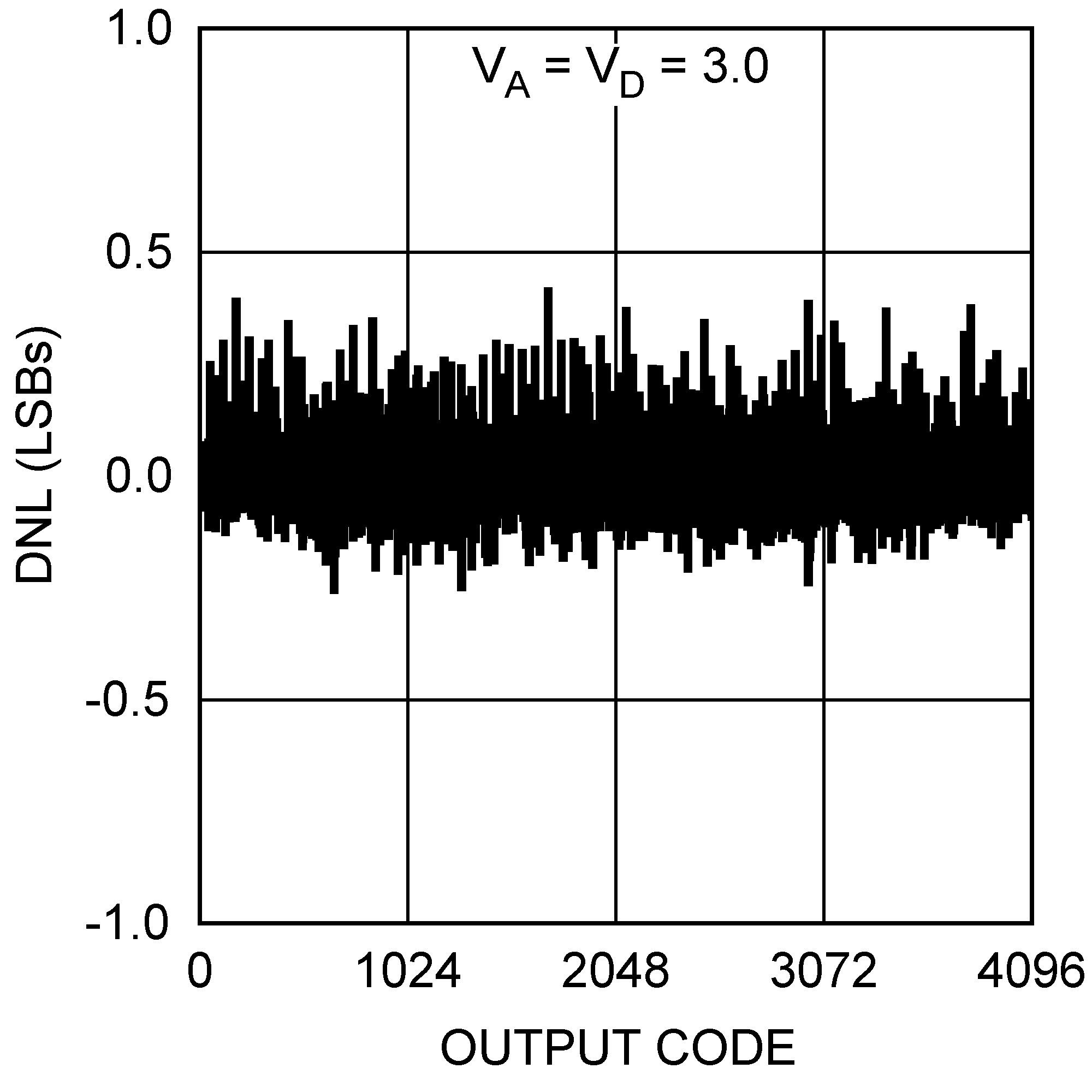SNAS411P August 2008 – April 2017 ADC128S102QML-SP
PRODUCTION DATA.
- 1 Features
- 2 Applications
- 3 Description
- 4 Revision History
- 5 Pin Configuration and Functions
-
6 Specifications
- 6.1 Absolute Maximum Ratings
- 6.2 ESD Ratings
- 6.3 Recommended Operating Conditions
- 6.4 Thermal Information
- 6.5 Electrical Characteristics: ADC128S102QML-SP Converter
- 6.6 Electrical Characteristics: Radiation
- 6.7 Electrical Characteristics: Burn in Delta Parameters - TA at 25°C
- 6.8 Timing Requirements
- 6.9 Typical Characteristics
- 7 Detailed Description
- 8 Application and Implementation
- 9 Power Supply Recommendations
- 10Layout
- 11Device and Documentation Support
- 12Mechanical, Packaging, and Orderable Information
Package Options
Refer to the PDF data sheet for device specific package drawings
Mechanical Data (Package|Pins)
- NAC|16
- Y|0
- NAD|16
Thermal pad, mechanical data (Package|Pins)
Orderable Information
6 Specifications
6.1 Absolute Maximum Ratings(1)
| MIN | MAX | UNIT | ||
|---|---|---|---|---|
| VA | Analog supply voltage | –0.3 | 6.5 | V |
| VD | Digital supply voltage(4) | –0.3 | VA + 0.3 | V |
| Voltage on any pin to GND | –0.3 | VA + 0.3 | V | |
| Input current at any pin (2) | ±10 | mA | ||
| Power dissipation TA = 25°C | See (3) | |||
| Package input current(2) | ±20 mA | mA | ||
| Soldering temperature, 10 seconds | 260 | °C | ||
| Junction temperature | 175 | °C | ||
| Tstg | Storage temperature | –65 | 150 | °C |
(1) Stresses beyond those listed under Absolute Maximum Ratings may cause permanent damage to the device. These are stress ratings only, and functional operation of the device at these or any other conditions beyond those indicated under Recommended Operating Conditions is not implied. Exposure to absolute-maximum-rated conditions for extended periods may affect device reliability.
(2) When the input voltage at any pin exceeds the power supplies (that is, VIN less than AGND or VIN greater than VA or VD), the current at that pin should be limited to 10 mA. The 20 mA maximum package input current rating limits the number of pins that can safely exceed the power supplies with an input current of 10 mA to two.
(3) The absolute maximum junction temperature (TJmax) for this device is 175°C. The maximum allowable power dissipation is dictated by TJmax, the junction-to-ambient thermal resistance (RθJA), and the ambient temperature (TA), and can be calculated using the formula PDMAX = (TJmax − TA)/RθJA. The values for maximum power dissipation listed above will be reached only when the ADC128S102QML-SP is operated in a severe fault condition (for example, when input or output pins are driven beyond the power supply voltages, or the power supply polarity is reversed). Obviously, such conditions should always be avoided.
(4) The maximum voltage is not to exceed 6.5 V
6.2 ESD Ratings
| VALUE | UNIT | |||
|---|---|---|---|---|
| V(ESD) | Electrostatic discharge | Human-body model (HBM), per ANSI/ESDA/JEDEC JS-001(1)(2) | ±8000 | V |
(1) JEDEC document JEP155 states that 500-V HBM allows safe manufacturing with a standard ESD control process.
(2) Human body model is 100-pF capacitor discharged through a 1.5-kΩ resistor. Machine model is 220 pF discharged through 0 Ω.
6.3 Recommended Operating Conditions
See (1)(2)| MIN | MAX | UNIT | ||
|---|---|---|---|---|
| Operating temperature | –55 | 125 | °C | |
| VA supply voltage | 2.7 | 5.25 | V | |
| VD supply voltage | 2.7 | VA | V | |
| Digital input voltage | 0 | VA | V | |
| Analog input voltage | 0 | VA | V | |
| Clock frequency | 0.8 | 16 | MHz | |
(1) Absolute Maximum Ratings indicate limits beyond which damage to the device may occur. Recommended Operating Conditions indicate conditions for which the device is functional, but do not verify specific performance limits. For specifications and test conditions, see the Electrical Characteristics. The specified specifications apply only for the test conditions listed. Some performance characteristics may degrade when the device is not operated under the listed test conditions.
(2) All voltages are measured with respect to GND = 0 V, unless otherwise specified.
6.4 Thermal Information
| THERMAL METRIC(1) | ACD128S102QML-SP | UNIT | |
|---|---|---|---|
| NAC (CFP) | |||
| 16 PINS | |||
| RθJA | Junction-to-ambient thermal resistance | 127 | °C/W |
| RθJC(top) | Junction-to-case (top) thermal resistance | 11.2 | °C/W |
(1) For more information about traditional and new thermal metrics, see the Semiconductor and IC Package Thermal Metrics application report.
6.5 Electrical Characteristics: ADC128S102QML-SP Converter
The following specifications apply for AGND = DGND = 0V, fSCLK = 0.8 MHz to 16 MHz, fSAMPLE = 50 kSPS to 1 MSPS, CL = 50pF, unless otherwise noted.| PARAMETER | TEST CONDITIONS | SUBGROUP | MIN | TYP(1) | MAX | UNIT | ||
|---|---|---|---|---|---|---|---|---|
| STATIC CONVERTER CHARACTERISTICS | ||||||||
| Resolution with no missing codes | 12 | Bits | ||||||
| INL | Integral non-linearity (end point method) | VA = VD = 3 V | [1, 2, 3] | –1 | ±0.6 | 1.1 | LSB | |
| VA = VD = 5 V | [1, 2, 3] | –1.25 | ±0.9 | 1.4 | LSB | |||
| DNL | Differential non-linearity | VA = VD = 3 V | [1, 2, 3] | 0.5 | 0.9 | LSB | ||
| [1, 2, 3] | –0.7 | –0.3 | LSB | |||||
| VA = VD = 5 V | [1, 2, 3] | 0.9 | 1.5 | LSB | ||||
| [1, 2, 3] | –0.9 | −0.5 | LSB | |||||
| VOFF | Offset error | VA = VD = 3 V | [1, 2, 3] | –2.3 | 0.8 | 2.3 | LSB | |
| VA = VD = 5 V | [1, 2, 3] | –2.3 | 1.1 | 2.3 | LSB | |||
| OEM | Offset error match | VA = VD = 3 V | [1, 2, 3] | –1.5 | ±0.1 | 1.5 | LSB | |
| VA = VD = 5 V | [1, 2, 3] | –1.5 | ±0.3 | 1.5 | LSB | |||
| FSE | Full scale error | VA = VD = 3 V | [1, 2, 3] | –2 | 0.8 | 2 | LSB | |
| VA = VD = 5 V | [1, 2, 3] | –2 | 0.3 | 2 | LSB | |||
| FSEM | Full scale error match | VA = VD = 3 V | [1, 2, 3] | –1.5 | ±0.1 | 1.5 | LSB | |
| VA = VD = 5 V | [1, 2, 3] | –1.5 | ±0.3 | 1.5 | LSB | |||
| DYNAMIC CONVERTER CHARACTERISTICS | ||||||||
| FPBW | Full power bandwidth (–3 dB) | VA = VD = 3 V | 6.8 | MHz | ||||
| VA = VD = 5 V | 10 | MHz | ||||||
| SINAD | Signal-to-noise plus distortion ratio | VA = VD = 3 V, fIN = 40.2 kHz, −0.02 dBFS |
[4, 5, 6] | 68 | 72 | dB | ||
| VA = VD = 5 V, fIN = 40.2 kHz, −0.02 dBFS |
[4, 5, 6] | 68 | 72 | dB | ||||
| SNR | Signal-to-noise ratio | VA = VD = 3 V, fIN = 40.2 kHz, −0.02 dBFS |
[4, 5, 6] | 69 | 72 | dB | ||
| VA = VD = 5 V, fIN = 40.2 kHz, −0.02 dBFS |
[4, 5, 6] | 68.5 | 72 | dB | ||||
| THD | Total harmonic distortion | VA = VD = 3 V, fIN = 40.2 kHz, −0.02 dBFS |
[4, 5, 6] | –86 | –74 | dB | ||
| VA = VD = 5 V, fIN = 40.2 kHz, −0.02 dBFS |
[4, 5, 6] | –87 | –74 | dB | ||||
| SFDR | Spurious-free dynamic range | VA = VD = 3 V, fIN = 40.2 kHz, −0.02 dBFS |
[4, 5, 6] | 75 | 91 | dB | ||
| VA = VD = 5 V, fIN = 40.2 kHz, −0.02 dBFS |
[4, 5, 6] | 75 | 90 | dB | ||||
| ENOB | Effective number of bits | VA = VD = 3 V, fIN = 40.2 kHz |
[4, 5, 6] | 11.1 | 11.6 | Bits | ||
| VA = VD = 5 V, fIN = 40.2 kHz, −0.02 dBFS |
[4, 5, 6] | 11.1 | 11.6 | Bits | ||||
| ISO | Channel-to-channel isolation | VA = VD = 3 V, fIN = 20 kHz |
84 | dB | ||||
| VA = VD = 5 V, fIN = 20 kHz, −0.02 dBFS |
85 | dB | ||||||
| IMD | Intermodulation distortion, second order terms | VA = VD = 3 V, fa = 19.5 kHz, fb = 20.5 kHz |
[4, 5, 6] | –93 | –78 | dB | ||
| VA = VD = 5 V, fa = 19.5 kHz, fb = 20.5 kHz |
[4, 5, 6] | –93 | –78 | dB | ||||
| Intermodulation distortion, third order terms | VA = VD = 3 V, fa = 19.5 kHz, fb = 20.5 kHz |
[4, 5, 6] | –91 | –70 | dB | |||
| VA = VD = 5 V, fa = 19.5 kHz, fb = 20.5 kHz |
[4, 5, 6] | –91 | –70 | dB | ||||
| ANALOG INPUT CHARACTERISTICS | ||||||||
| VIN | Input range | 0 to VA | V | |||||
| IDCL | DC leakage current | [1, 2, 3] | ±0.01 | ±1 | µA | |||
| CINA | Input capacitance | Track mode, see (2) | 38 | pF | ||||
| Hold mode, see (2) | 4.5 | pF | ||||||
| DIGITAL INPUT CHARACTERISTICS | ||||||||
| VIH | Input high voltage | VA = VD = 2.7 V to 3.6 V | [1, 2, 3] | 2.1 | V | |||
| VA = VD = 4.75 V to 5.25 V | [1, 2, 3] | 2.4 | V | |||||
| VIL | Input low voltage | VA = VD = 2.7 V to 5.25 V | [1, 2, 3] | 0.8 | V | |||
| IIN | Input current | VIN = 0 V or VD | [1, 2, 3] | ±1 | ±1 | µA | ||
| CIND | Digital input capacitance | See (2) | 3.5 | pF | ||||
| DIGITAL OUTPUT CHARACTERISTICS | ||||||||
| VOH | Output high voltage | ISOURCE = 200 µA, VA = VD = 2.7 V to 5.25 V |
[1, 2, 3] | VD –0.5 | V | |||
| VOL | Output low voltage | ISINK = 200 µA to 1 mA, VA = VD = 2.7 V to 5.25 V |
[1, 2, 3] | 0.4 | V | |||
| IOZH, IOZL | Hi-impedance output leakage current | VA = VD = 2.7 V to 5.25 V | [1, 2, 3] | ±0.01 | ±1 | µA | ||
| COUT | Hi-impedance output capacitance | See (2) | 3.5 | pF | ||||
| Output coding | Straight (Natural) Binary | |||||||
| POWER SUPPLY CHARACTERISTICS (CL = 10 pF) | ||||||||
| VA, VD | Analog and digital supply voltages | VA ≥ VD | [1, 2, 3] | 2.7 | V | |||
| [1, 2, 3] | 5.25 | V | ||||||
| IA + ID | Total supply current, normal mode ( CS low) |
VA = VD = 2.7 V to 3.6 V, fSAMPLE = 1 MSPS, fIN = 40 kHz |
[1, 2, 3] | 0.9 | 1.5 | mA | ||
| VA = VD = 4.75 V to 5.25 V, fSAMPLE = 1 MSPS, fIN = 40 kHz |
[1, 2, 3] | 2.2 | 3.1 | mA | ||||
| Total supply current, shutdown mode (CS high) |
VA = VD = 2.7 V to 3.6 V, fSCLK = 0 kSPS |
[1, 2, 3] | 0.11 | 1 | μA | |||
| VA = VD = 4.75 V to 5.25 V, fSCLK = 0 kSPS |
[1, 2, 3] | 0.12 | 1.4 | μA | ||||
| PC | Power consumption, normal mode ( CS low) |
VA = VD = 3 V fSAMPLE = 1 MSPS, fIN = 40 kHz |
[1, 2, 3] | 2.7 | 4.5 | mW | ||
| VA = VD = 5 V fSAMPLE = 1 MSPS, fIN = 40 kHz |
[1, 2, 3] | 11.0 | 15.5 | mW | ||||
| Power consumption, shutdown mode (CS high) |
VA = VD = 3 V fSCLK = 0 kSPS |
[1, 2, 3] | 0.33 | 3 | µW | |||
| VA = VD = 5 V fSCLK = 0 kSPS |
[1, 2, 3] | 0.6 | 7 | µW | ||||
| AC ELECTRICAL CHARACTERISTICS | ||||||||
| fSCLKMIN | Minimum clock frequency | VA = VD = 2.7 V to 5.25 V | [9, 10, 11] | 0.8 | MHz | |||
| fSCLK | Maximum clock frequency | VA = VD = 2.7 V to 5.25 V | [9, 10, 11] | 16 | MHz | |||
| fS | Sample rate continuous mode | VA = VD = 2.7 V to 5.25 V | [9, 10, 11] | 50 | kSPS | |||
| [9, 10, 11] | 1 | MSPS | ||||||
| tCONVERT | Conversion (hold) time | VA = VD = 2.7 V to 5.25 V | [9, 10, 11] | 13 | SCLK cycles | |||
| DC | SCLK duty cycle | VA = VD = 2.7 V to 5.25 V | MIN | 40% | ||||
| MAX | 60% | |||||||
| tACQ | Acquisition (track) time | VA = VD = 2.7 V to 5.25 V | [9, 10, 11] | 3 | SCLK cycles | |||
| Throughput time | Acquisition time + conversion time VA = VD = 2.7 V to 5.25 V |
[9, 10, 11] | 16 | SCLK cycles | ||||
| tAD | Aperture delay | VA = VD = 2.7 V to 5.25 V | 4 | ns | ||||
(1) Typical figures are at TJ = 25°C, and represent most likely parametric norms.
(2) This parameter is specified by design and/or characterization and is not tested in production.
6.6 Electrical Characteristics: Radiation
The following specifications apply for VA = VD = 2.7 V to 5.25 V, AGND = DGND = 0 V, fSCLK = 0.8 MHz to 16 MHz, fSAMPLE = 50 kSPS to 1 MSPS, and CL = 50 pF.(1)| PARAMETER | TEST CONDITIONS | SUBGROUP | MIN | TYP | MAX | UNIT | |
|---|---|---|---|---|---|---|---|
| IA + ID | Total supply current shutdown mode (CS high) | VA = VD = 2.7 V to 3.6 V, fSCLK = 0 kSPS |
[1] | 30 | µA | ||
| VA = VD = 4.75 V to 5.25 V, fSCLK = 0 kSPS |
[1] | 100 | µA | ||||
| IOZH, IOZL | Hi-impedance output leakage current | VA = VD = 2.7 V to 5.25 V | [1] | ±10 | µA | ||
(1) Pre and post irradiation limits are identical to those listed in the DC Parameters and AC and Timing Characteristics, except as listed in Electrical Characteristics: Radiation. When performing post irradiation electrical measurements for any RHA level, TA = 25°C.
6.7 Electrical Characteristics: Burn in Delta Parameters - TA at 25°C
The following specifications apply for VA = VD = 2.7 V to 5.25 V, AGND = DGND = 0 V, fSCLK = 0.8 MHz to 16 MHz, fSAMPLE = 50 kSPS to 1 MSPS, and CL = 50 pF.(1)
(1) This is worse case drift, Deltas are performed at room temperature post operational life. All other parameters, no deltas are required.
6.8 Timing Requirements
The following specifications apply for VA = VD = 2.7 V to 5.25 V, AGND = DGND = 0 V, fSCLK = 0.8 MHz to 16 MHz, fSAMPLE = 50 kSPS to 1 MSPS, and CL = 50 pF.| SUBGROUP | MIN | NOM(1) | MAX | UNIT | |||
|---|---|---|---|---|---|---|---|
| tCSH | CS hold time after SCLK rising edge | See (2) | [9, 10, 11] | 10 | 0 | ns | |
| tCSS | CS setup time prior to SCLK rising edge | See (2) | [9, 10, 11] | 10 | 4.5 | ns | |
| tEN | CS falling edge to DOUT enabled | [9, 10, 11] | 5 | 30 | ns | ||
| tDACC | DOUT access time after SCLK falling edge | [9, 10, 11] | 17 | 27 | ns | ||
| tDHLD | DOUT hold time after SCLK falling edge | [9, 10, 11] | 7 | ns | |||
| tDS | DIN setup time prior to SCLK rising edge | [9, 10, 11] | 10 | ns | |||
| tDH | DIN hold time after SCLK rising edge | [9, 10, 11] | 10 | ns | |||
| tCH | SCLK high time | 0.4 × tSCLK | ns | ||||
| tCL | SCLK low time | 0.4 × tSCLK | ns | ||||
| tDIS | CS rising edge to DOUT high-impedance | DOUT falling | [9, 10, 11] | 2.4 | 20 | ns | |
| DOUT rising | [9, 10, 11] | 0.9 | 20 | ns | |||
(1) Typical figures are at TJ = 25°C, and represent most likely parametric norms.
(2) Clock may be in any state (high or low) when CS goes high. Setup and hold time restrictions apply only to CS going low.
Table 1. Quality Conformance Inspection(1)
| SUBGROUP | DESCRIPTION | TEMP (°C) |
|---|---|---|
| 1 | Static tests at | 25 |
| 2 | Static tests at | 125 |
| 3 | Static tests at | –55 |
| 4 | Dynamic tests at | 25 |
| 5 | Dynamic tests at | 125 |
| 6 | Dynamic tests at | –55 |
| 7 | Functional tests at | 25 |
| 8A | Functional tests at | 125 |
| 8B | Functional tests at | –55 |
| 9 | Switching tests at | 25 |
| 10 | Switching tests at | 125 |
| 11 | Switching tests at | –55 |
| 12 | Setting time at | 25 |
| 13 | Setting time at | 125 |
| 14 | Setting time at | –55 |
(1) MIL-STD-883, Method 5005 - Group A
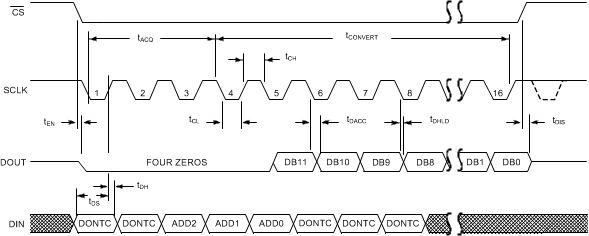 Figure 2. ADC128S102 Serial Timing Diagram
Figure 2. ADC128S102 Serial Timing Diagram
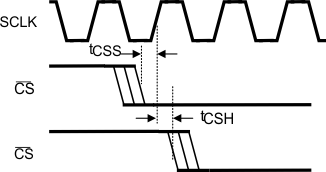 Figure 3. SCLK and CS Timing Parameters
Figure 3. SCLK and CS Timing Parameters
6.9 Typical Characteristics
TA = 25°C, fSAMPLE = 1 MSPS, fSCLK = 16 MHz, fIN = 40.2 kHz unless otherwise stated.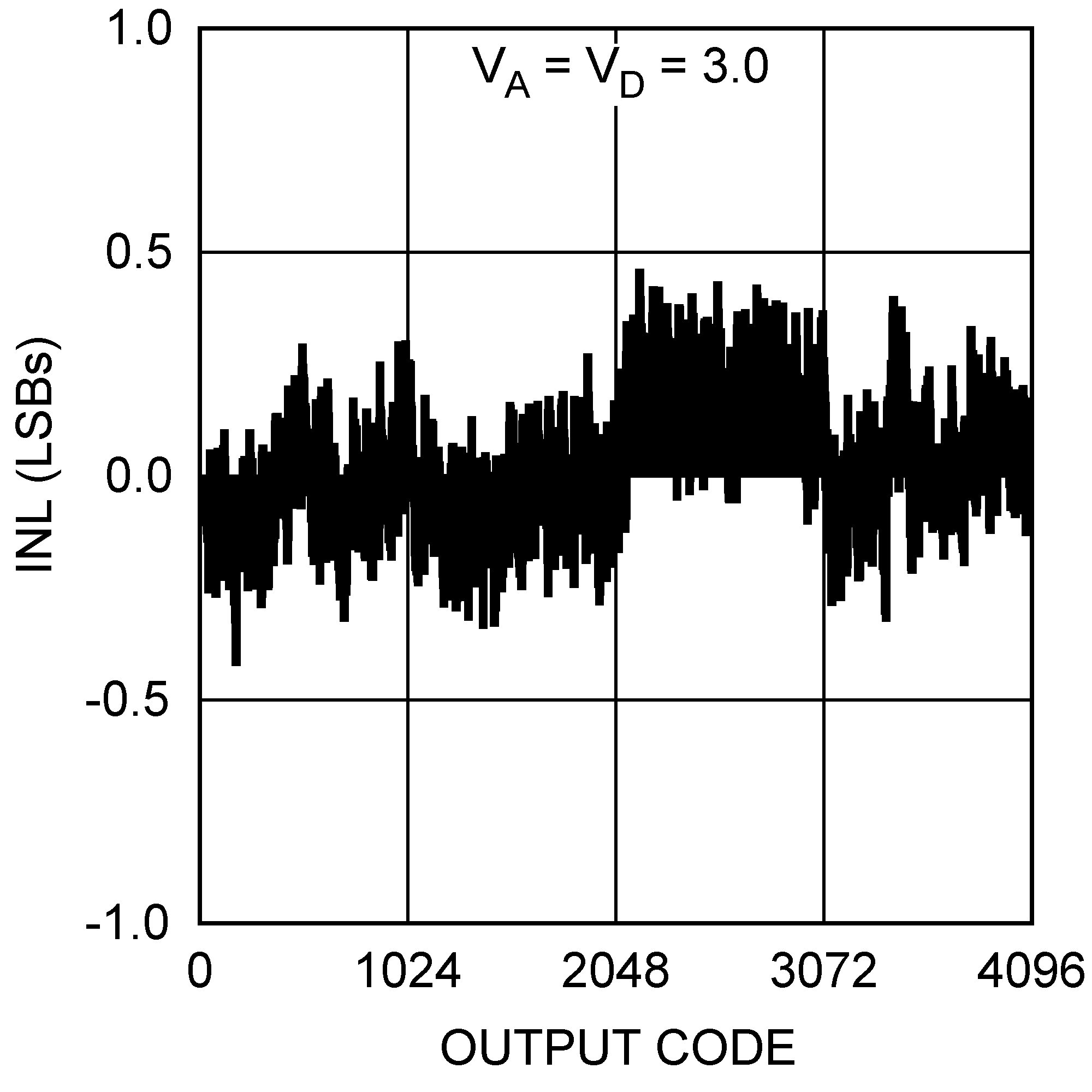 Figure 6. INL
Figure 6. INL
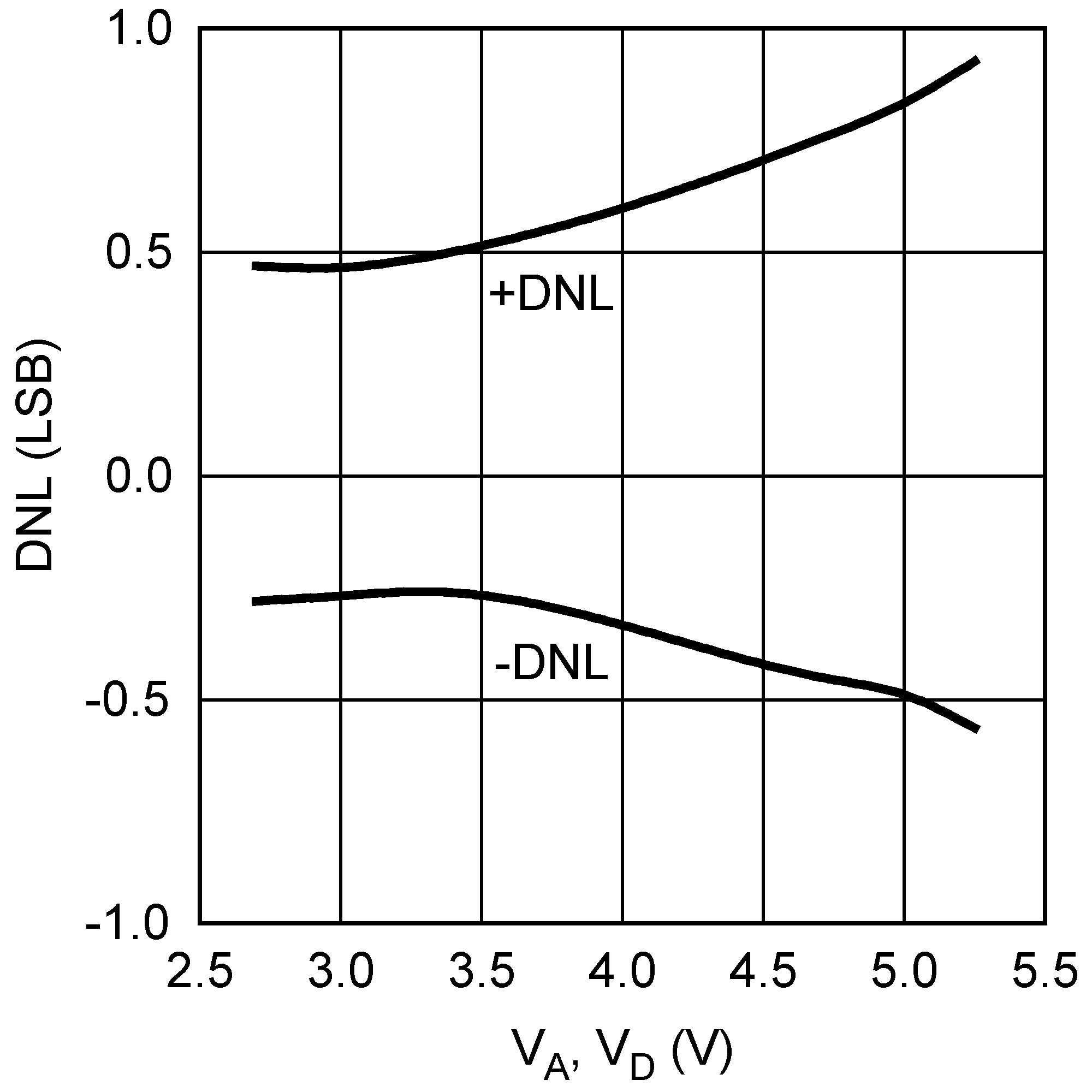 Figure 8. DNL vs Supply
Figure 8. DNL vs Supply
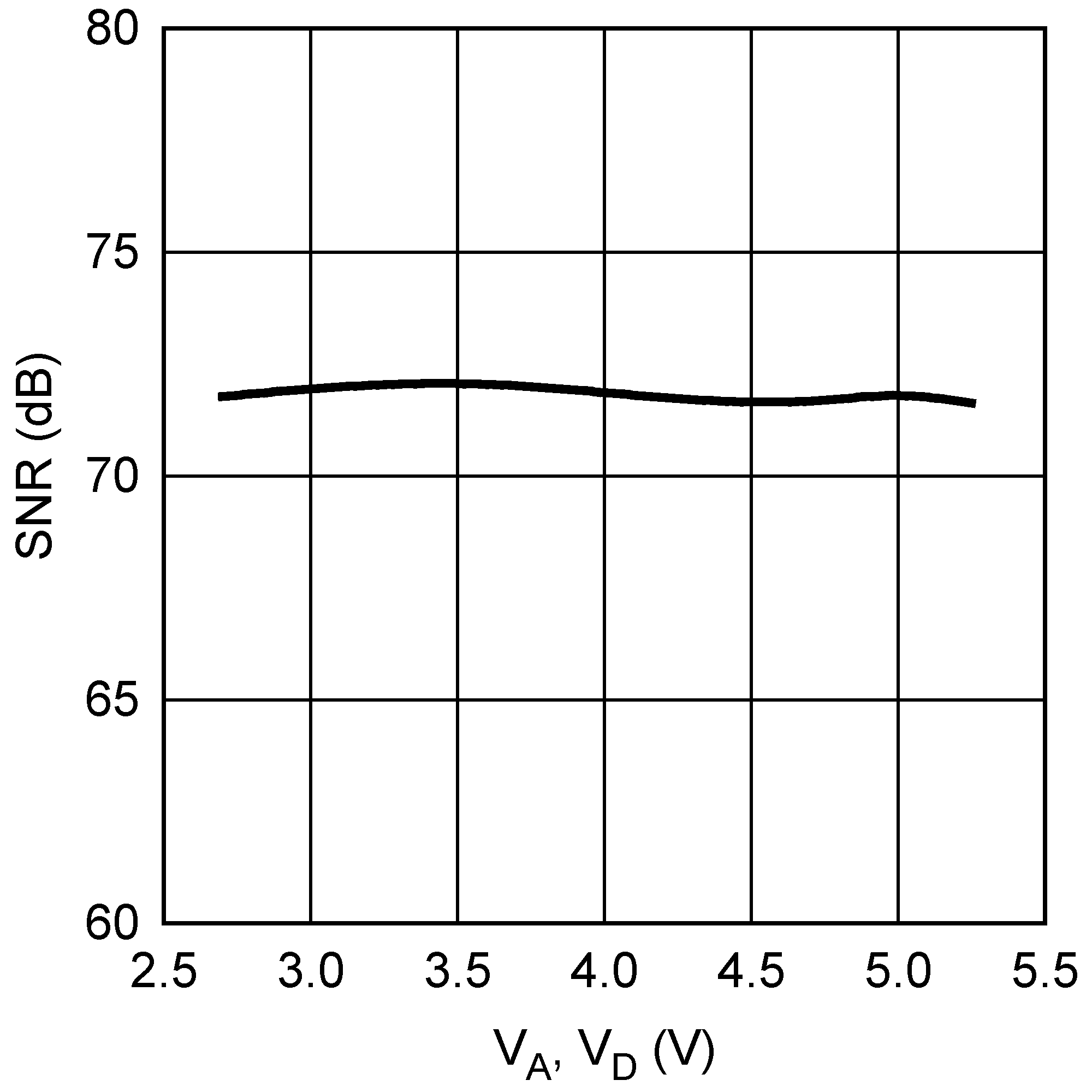 Figure 10. SNR vs Supply
Figure 10. SNR vs Supply
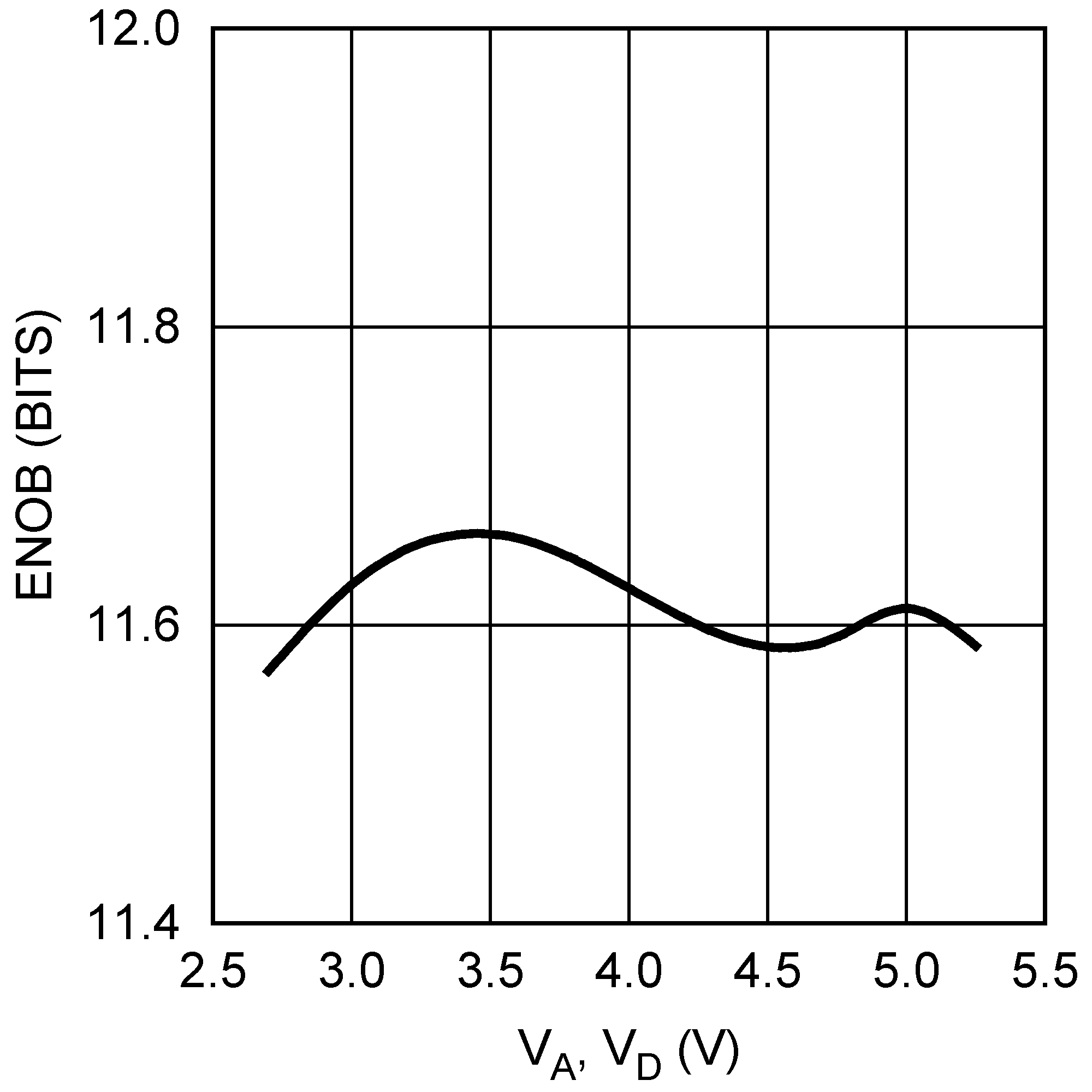 Figure 12. ENOB vs Supply
Figure 12. ENOB vs Supply
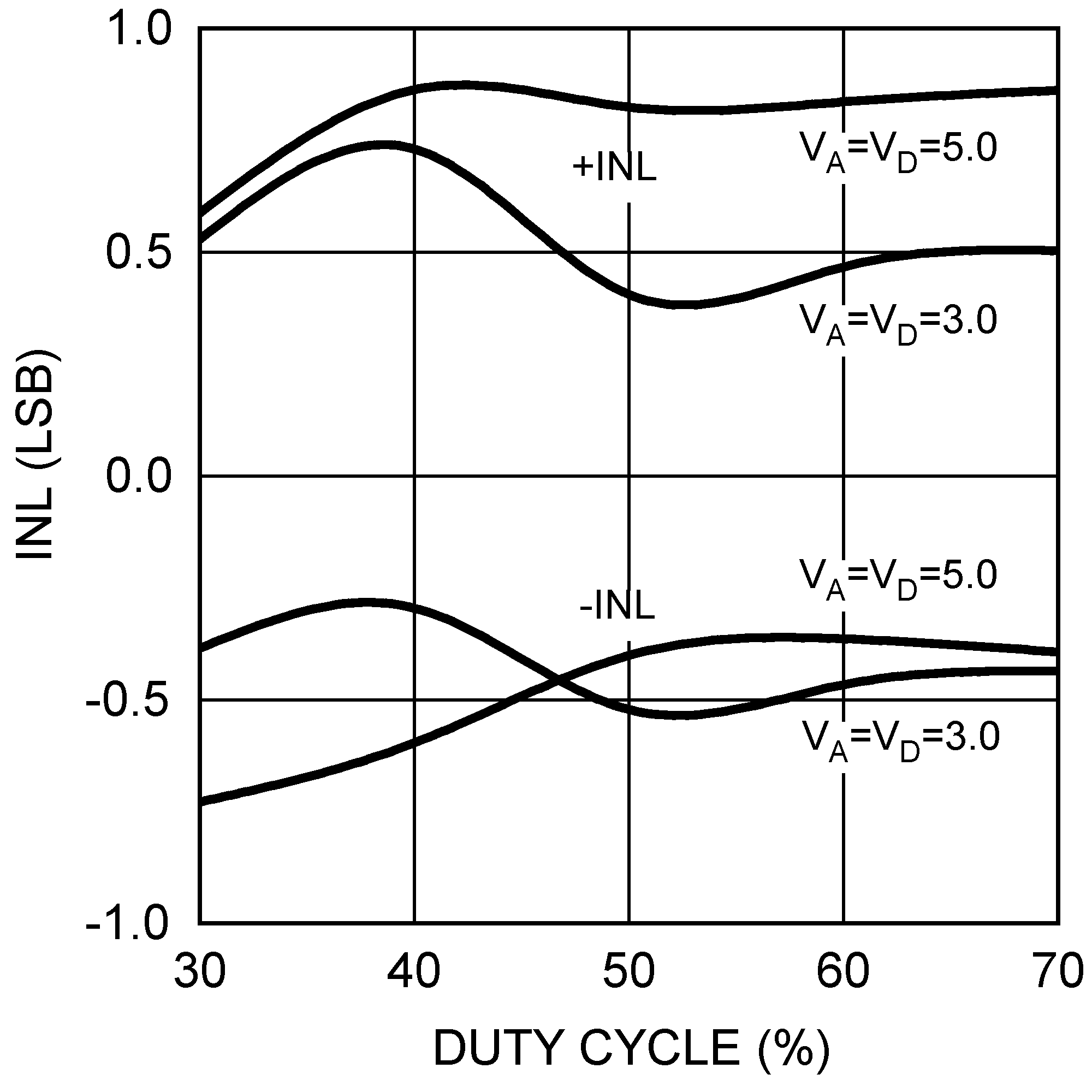 Figure 14. INL vs SCLK Duty Cycle
Figure 14. INL vs SCLK Duty Cycle
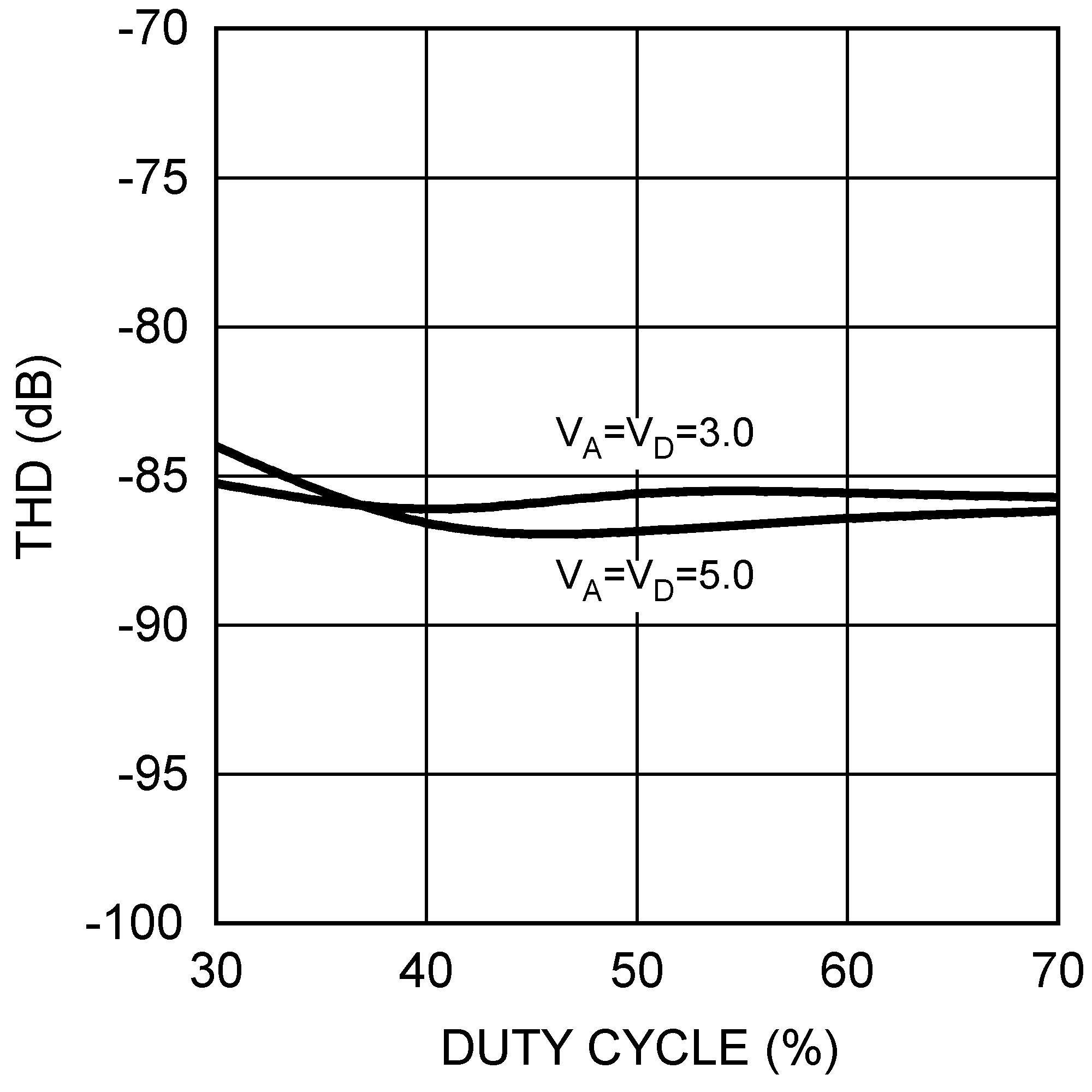 Figure 16. THD vs SCLK Duty Cycle
Figure 16. THD vs SCLK Duty Cycle
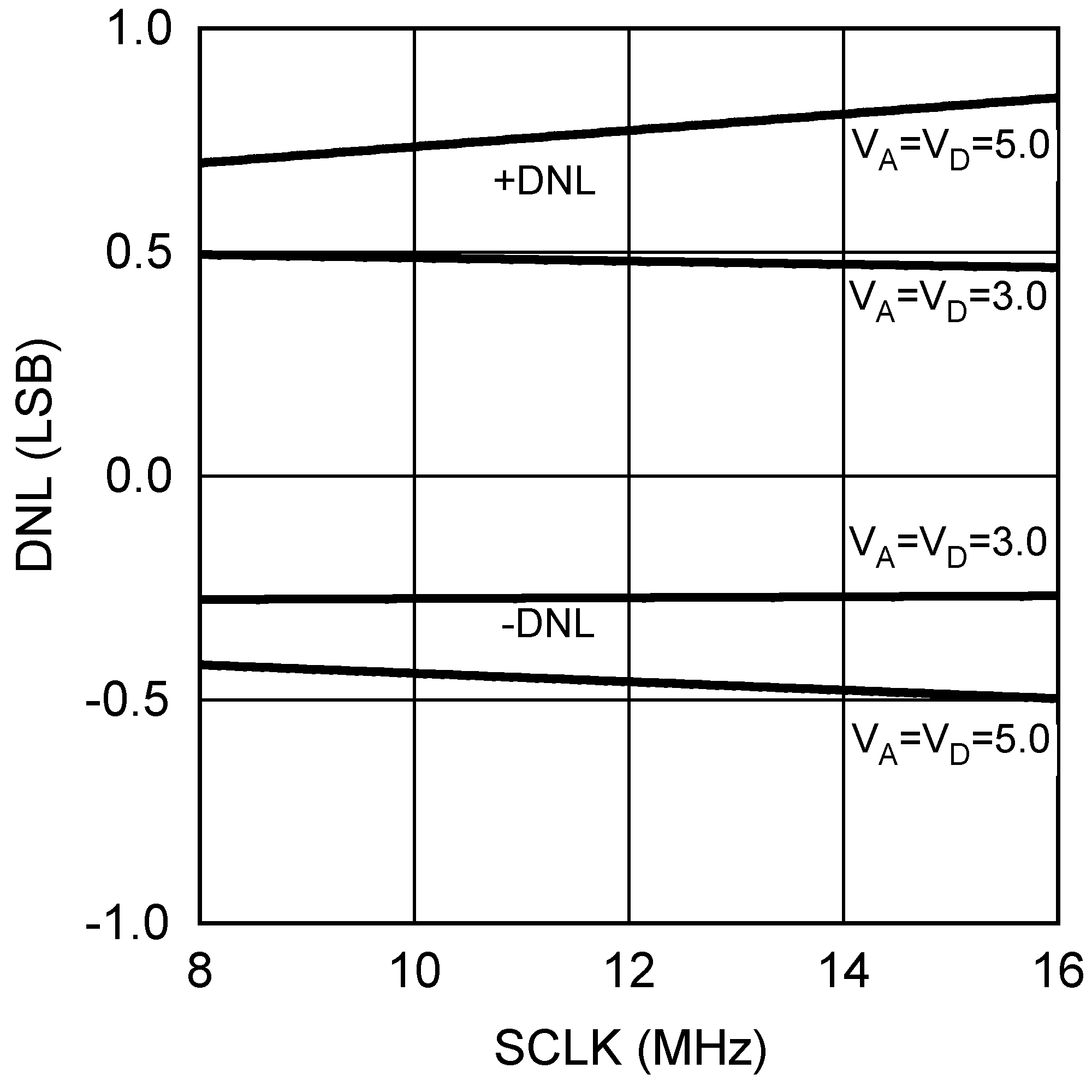 Figure 18. DNL vs SCLK
Figure 18. DNL vs SCLK
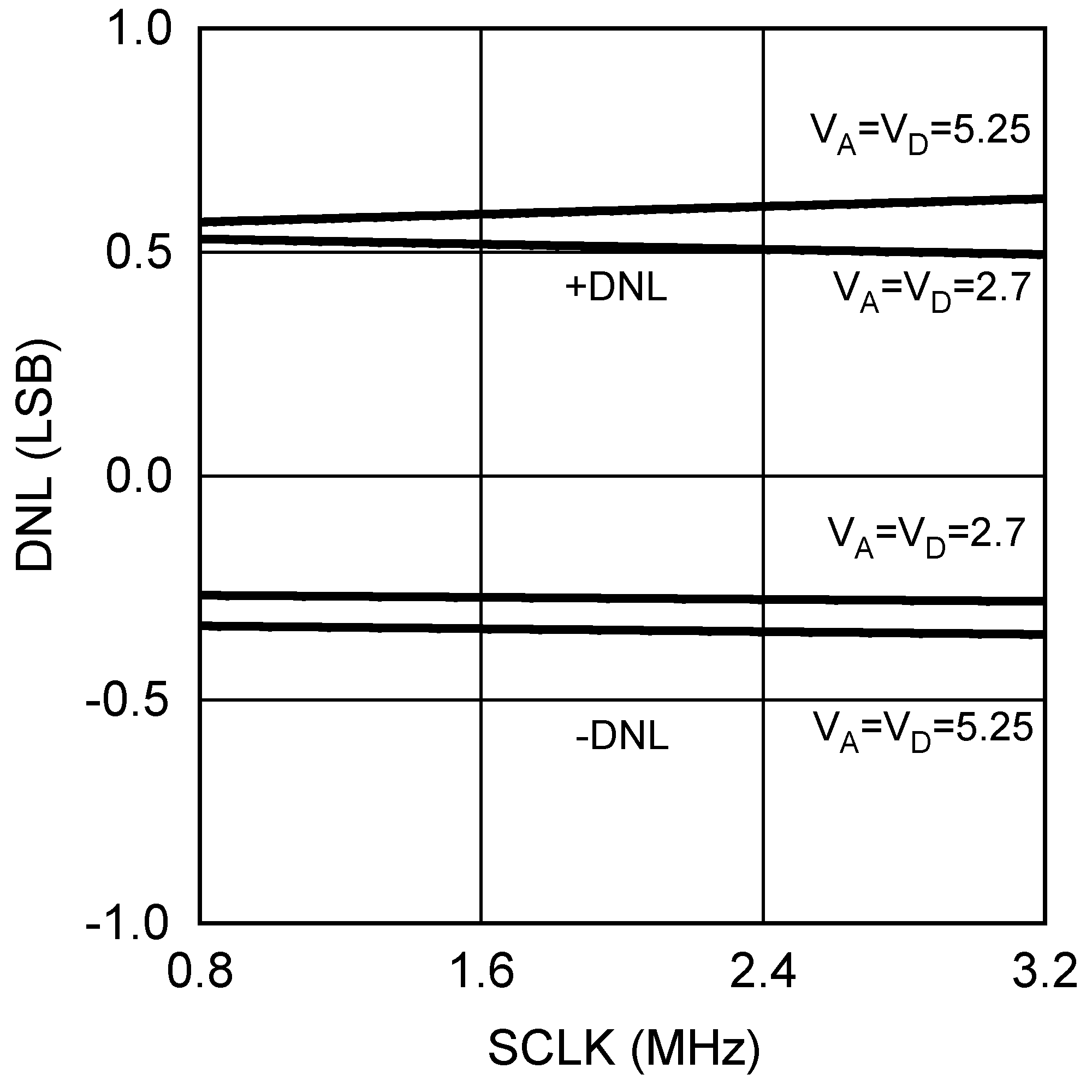 Figure 20. DNL vs SCLK
Figure 20. DNL vs SCLK
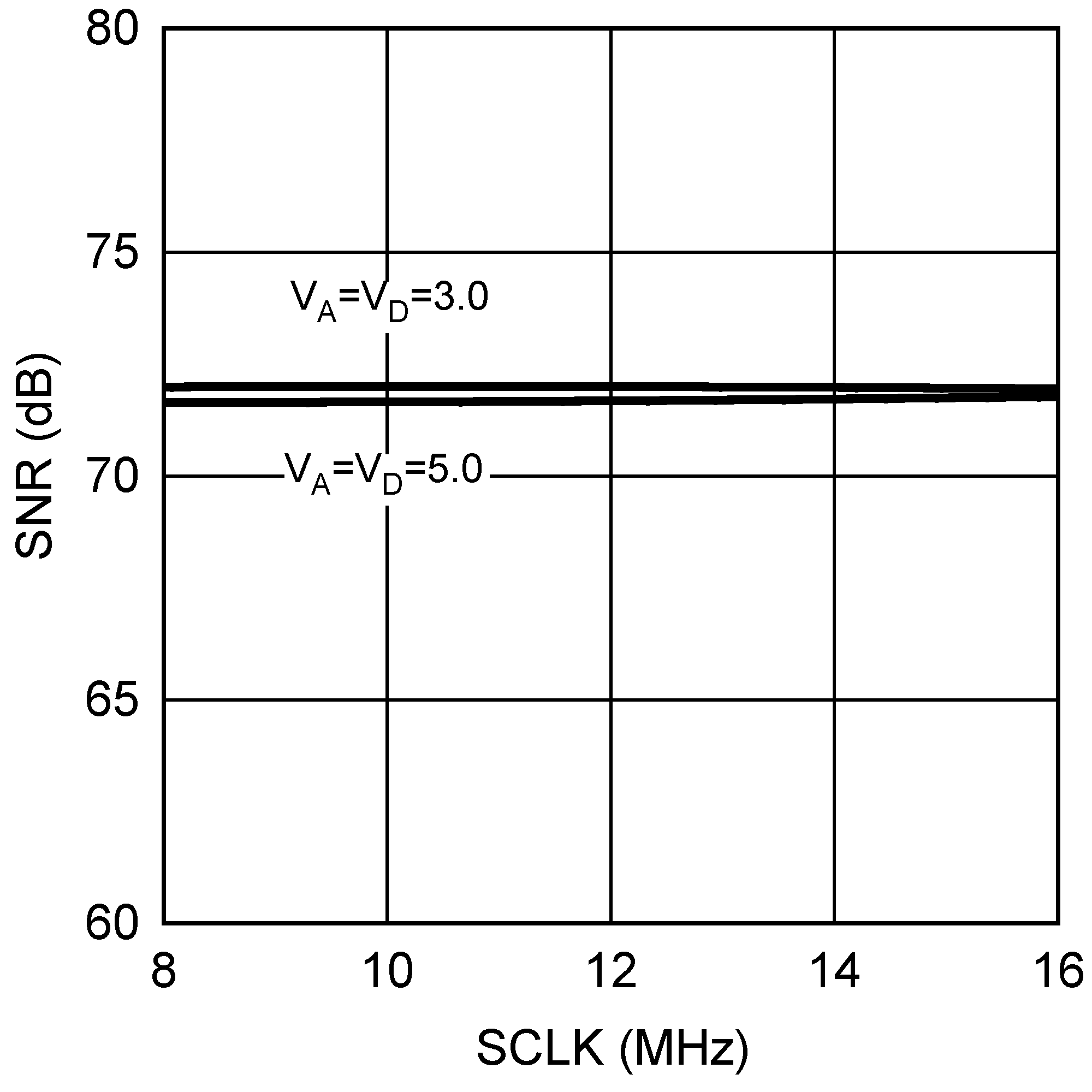 Figure 22. SNR vs SCLK
Figure 22. SNR vs SCLK
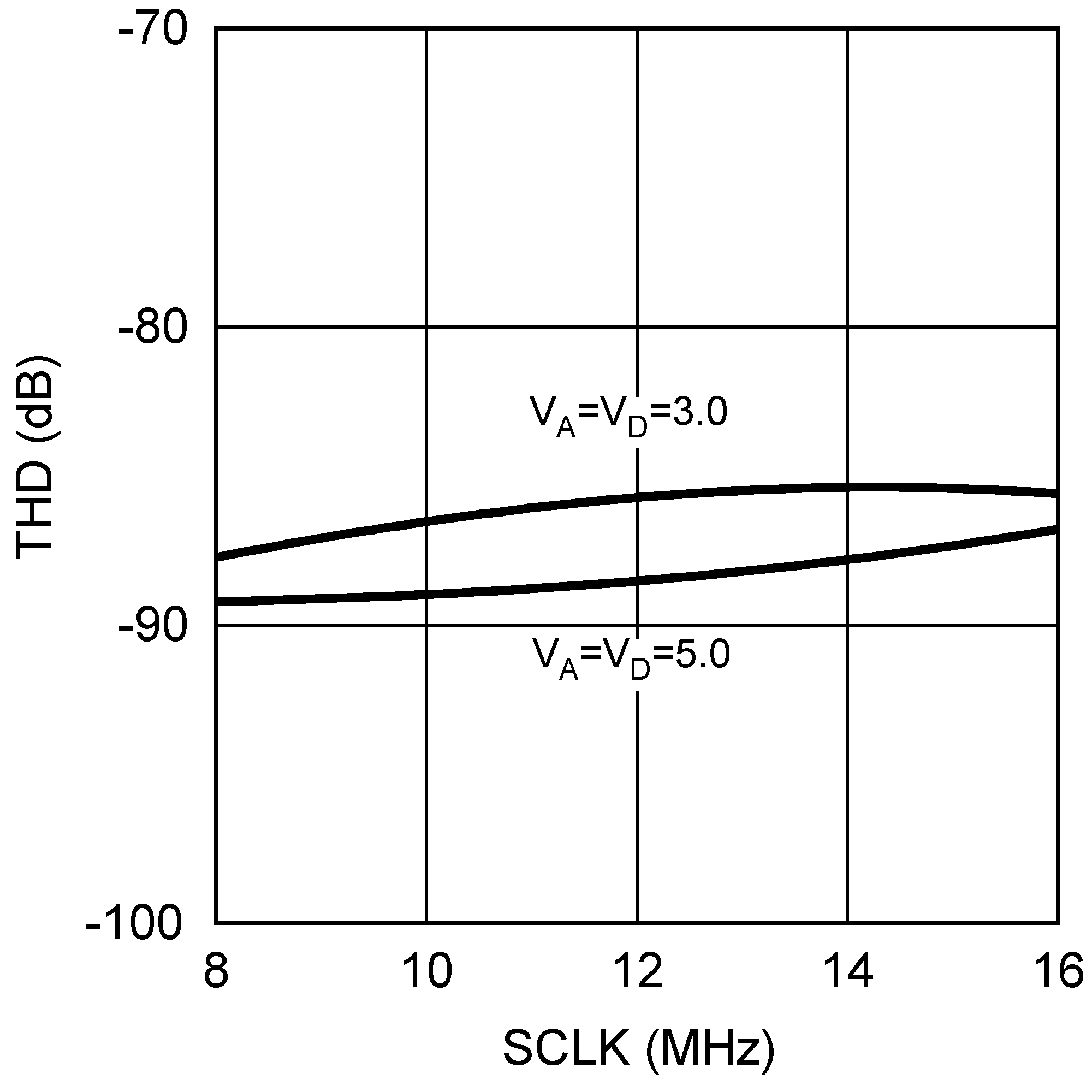 Figure 24. THD vs SCLK
Figure 24. THD vs SCLK
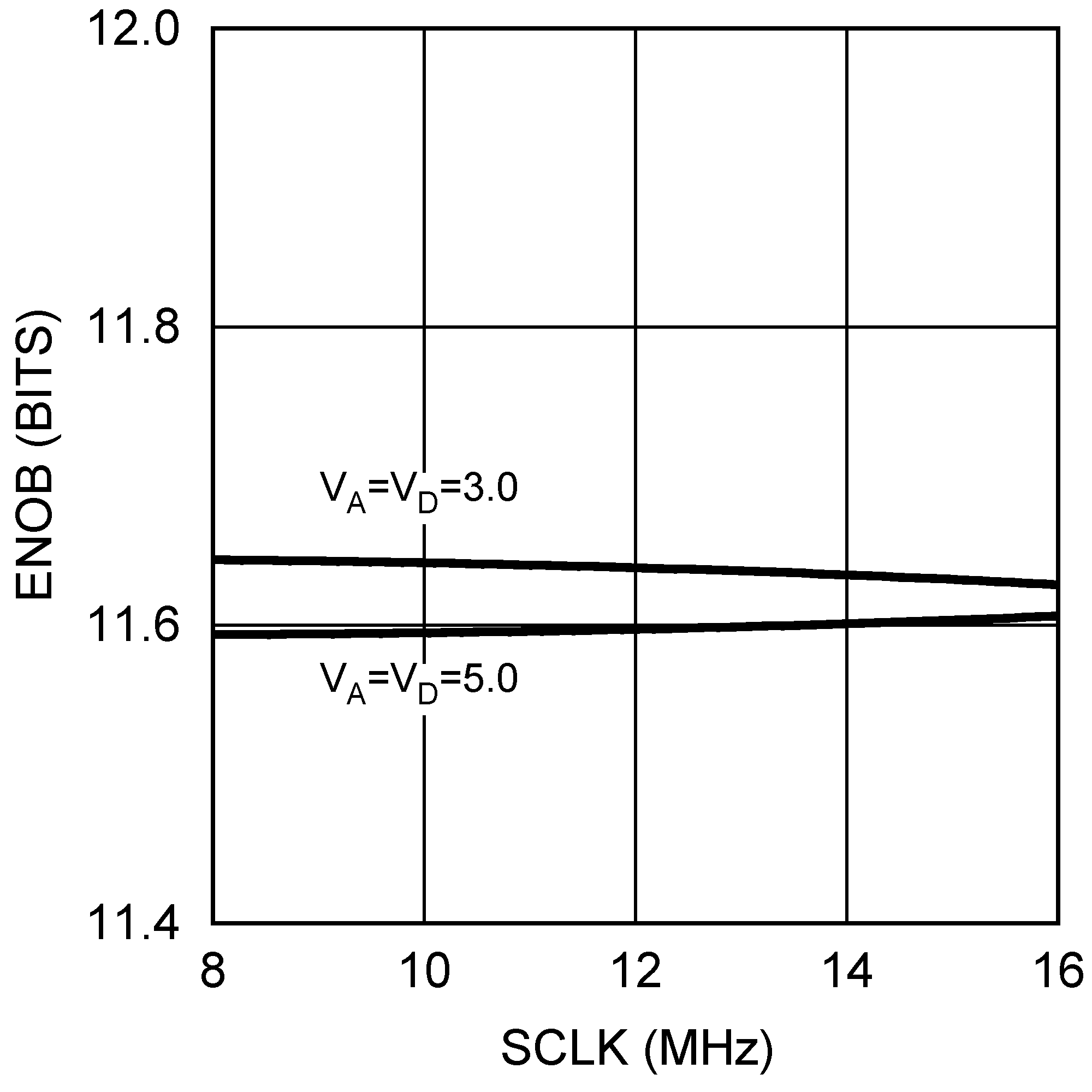 Figure 26. ENOB vs SCLK
Figure 26. ENOB vs SCLK
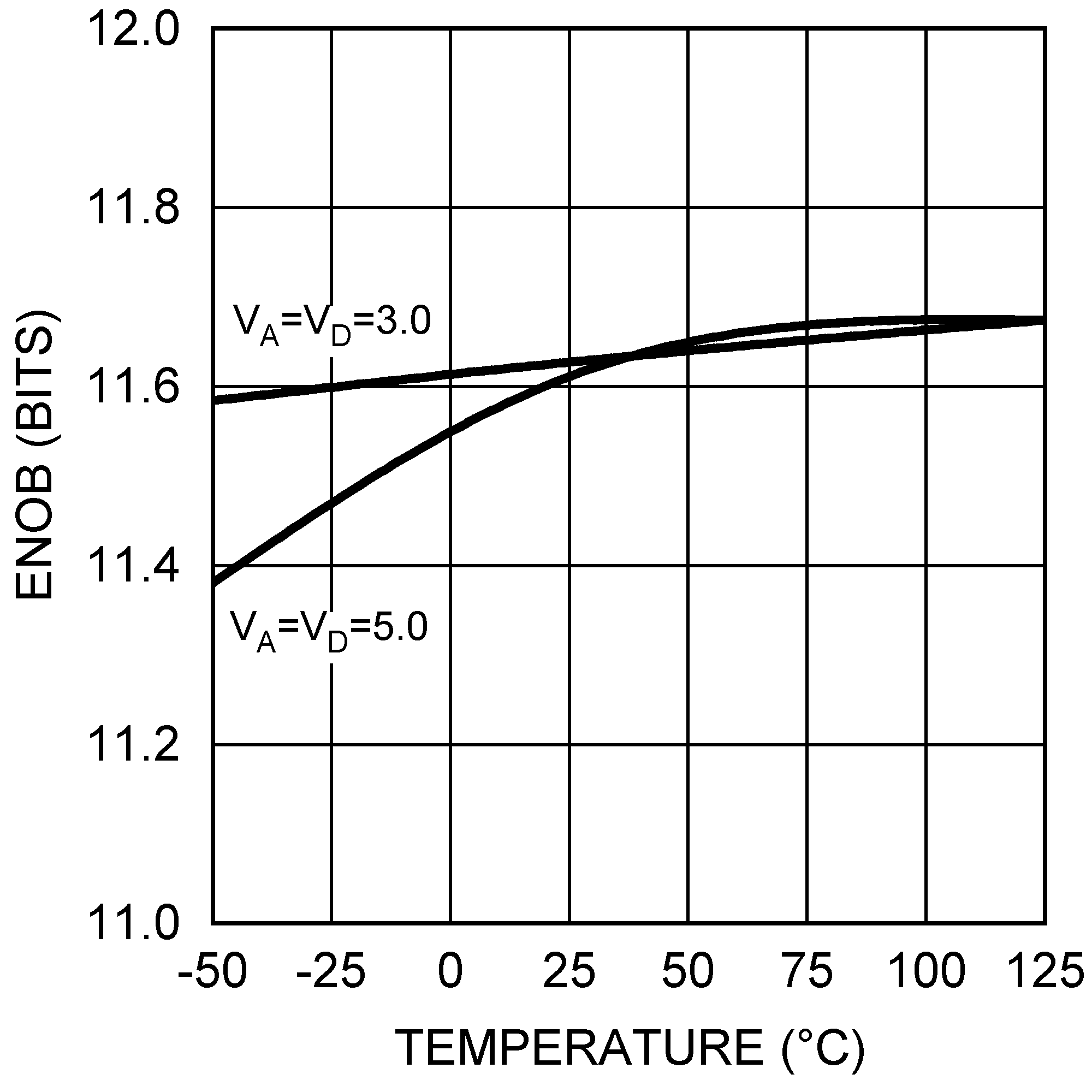 Figure 28. ENOB vs Temperature
Figure 28. ENOB vs Temperature
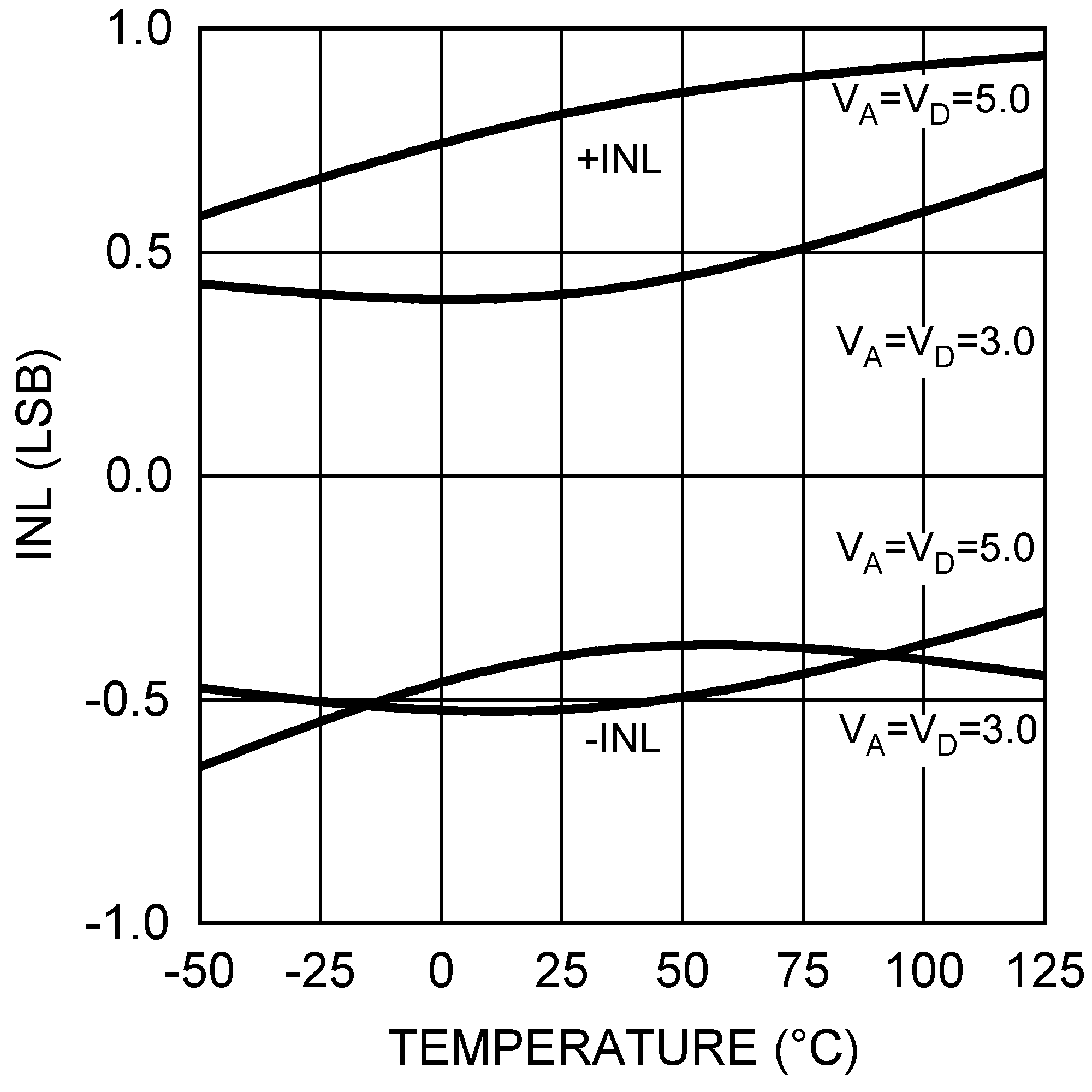 Figure 30. INL vs Temperature
Figure 30. INL vs Temperature
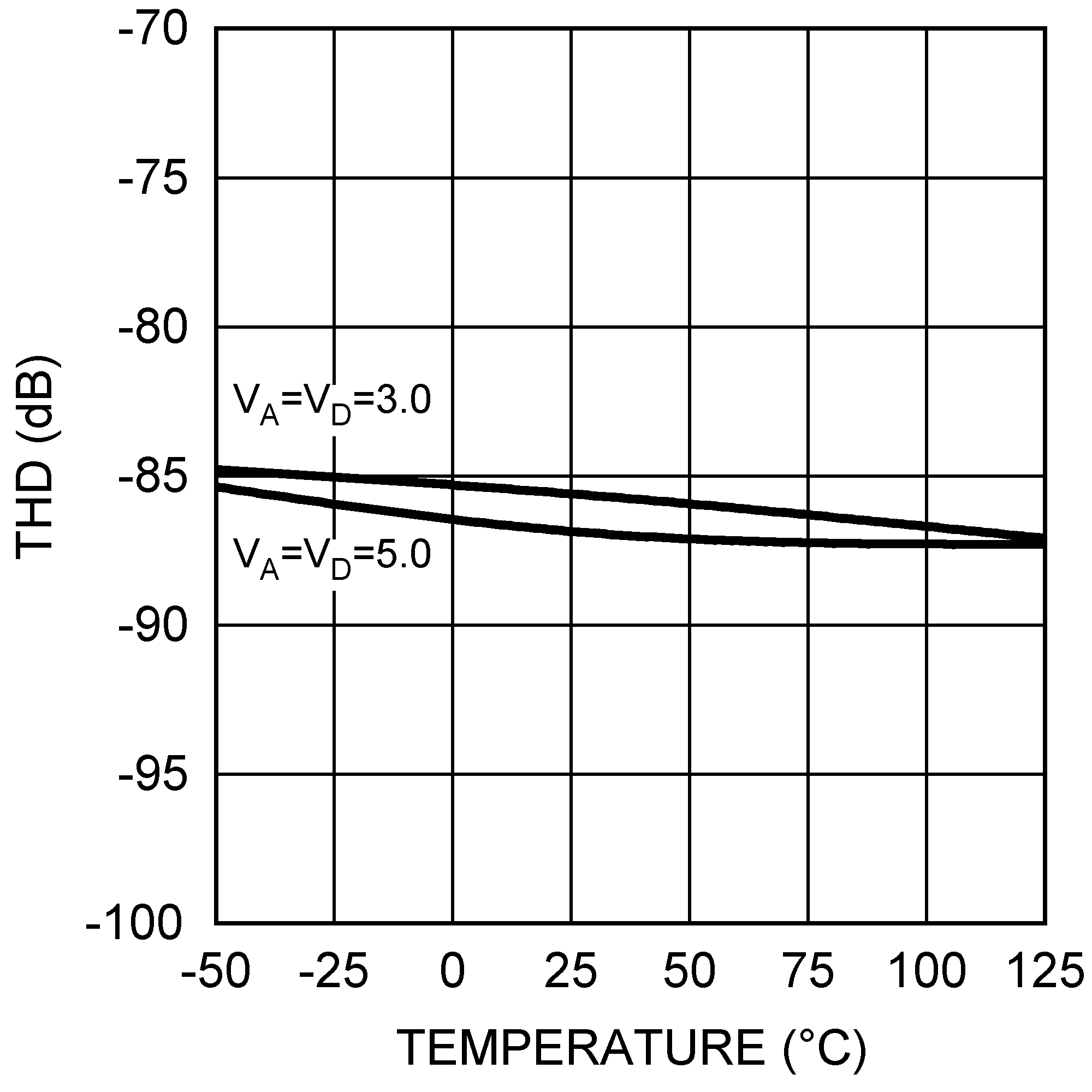 Figure 32. THD vs Temperature
Figure 32. THD vs Temperature
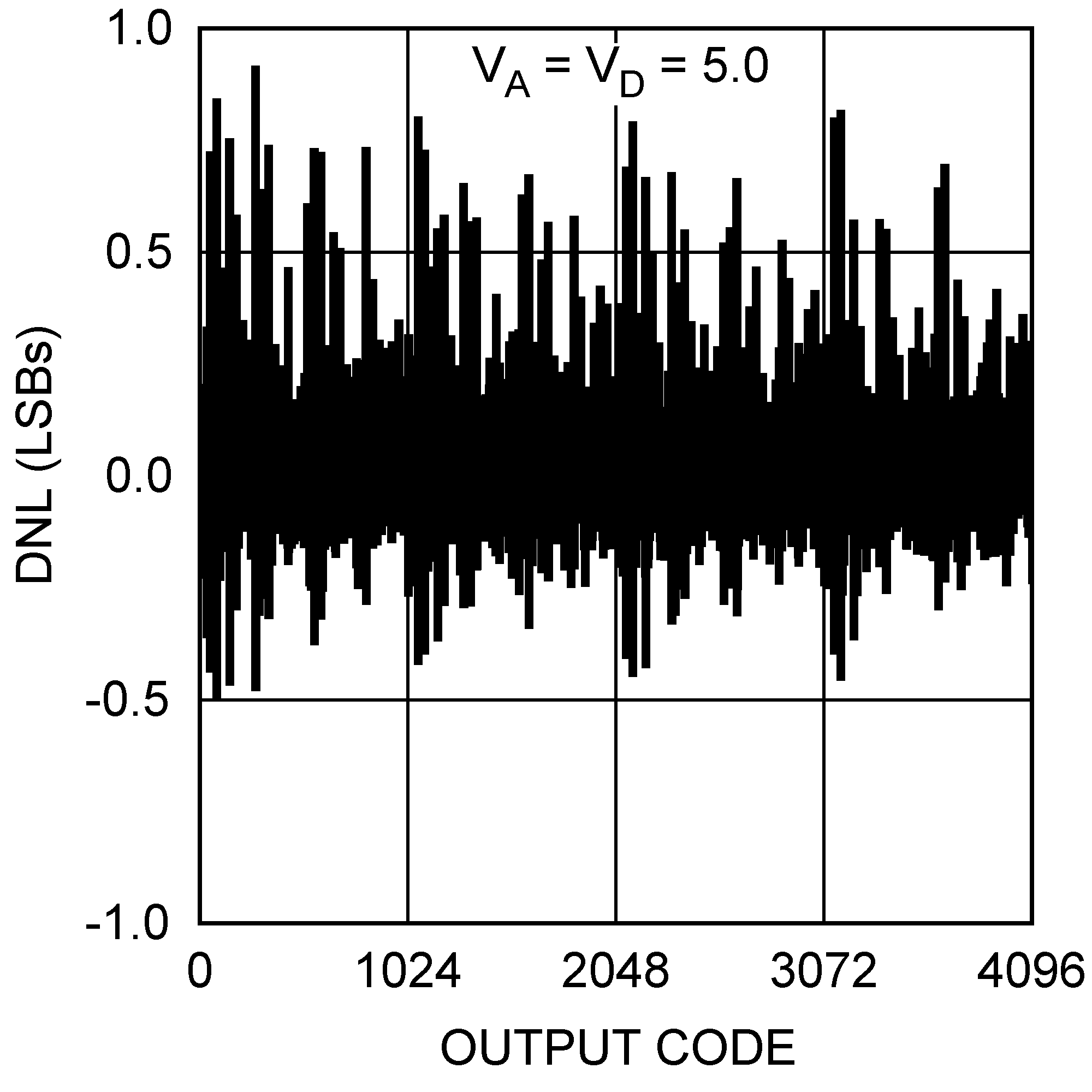 Figure 5. DNL
Figure 5. DNL
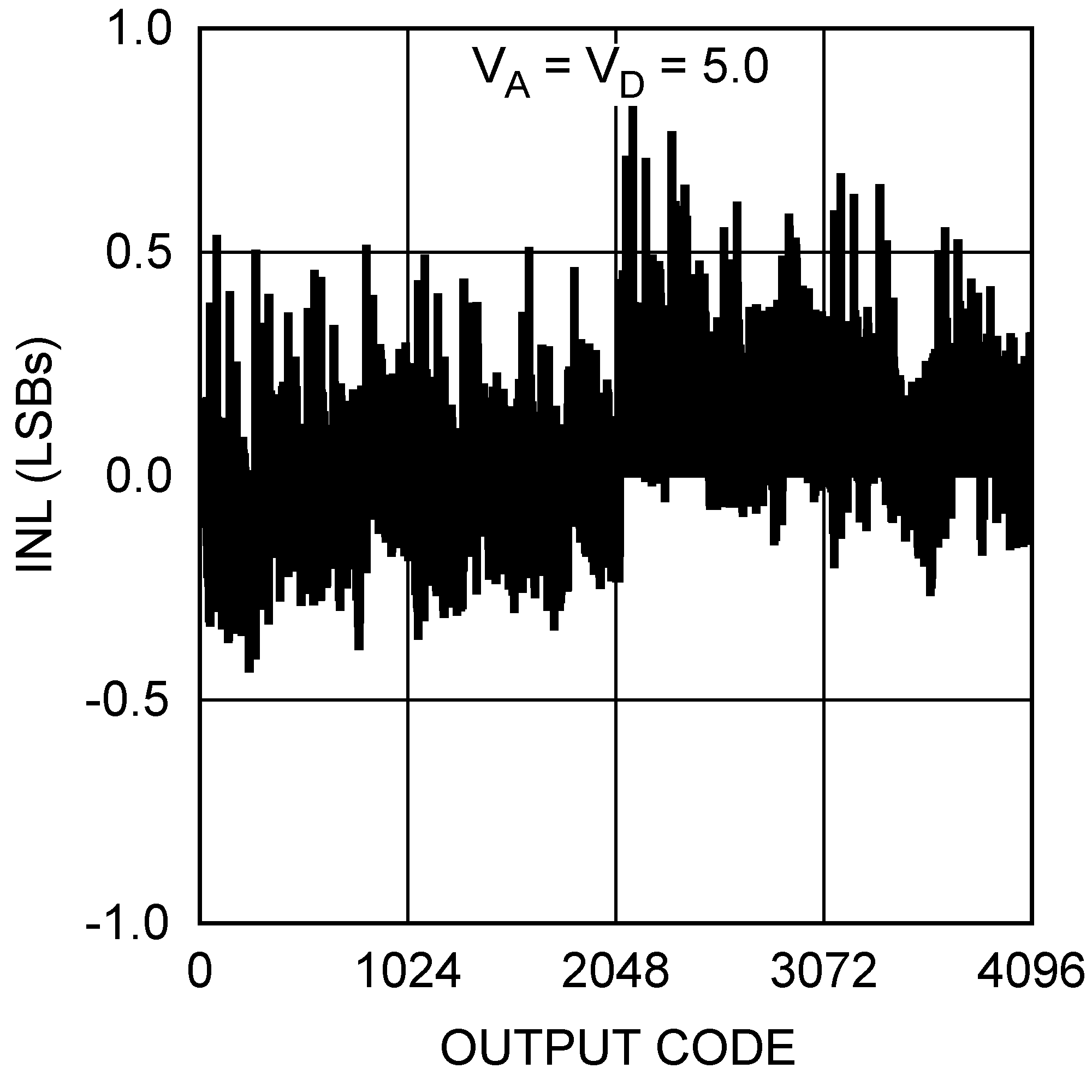 Figure 7. INL
Figure 7. INL
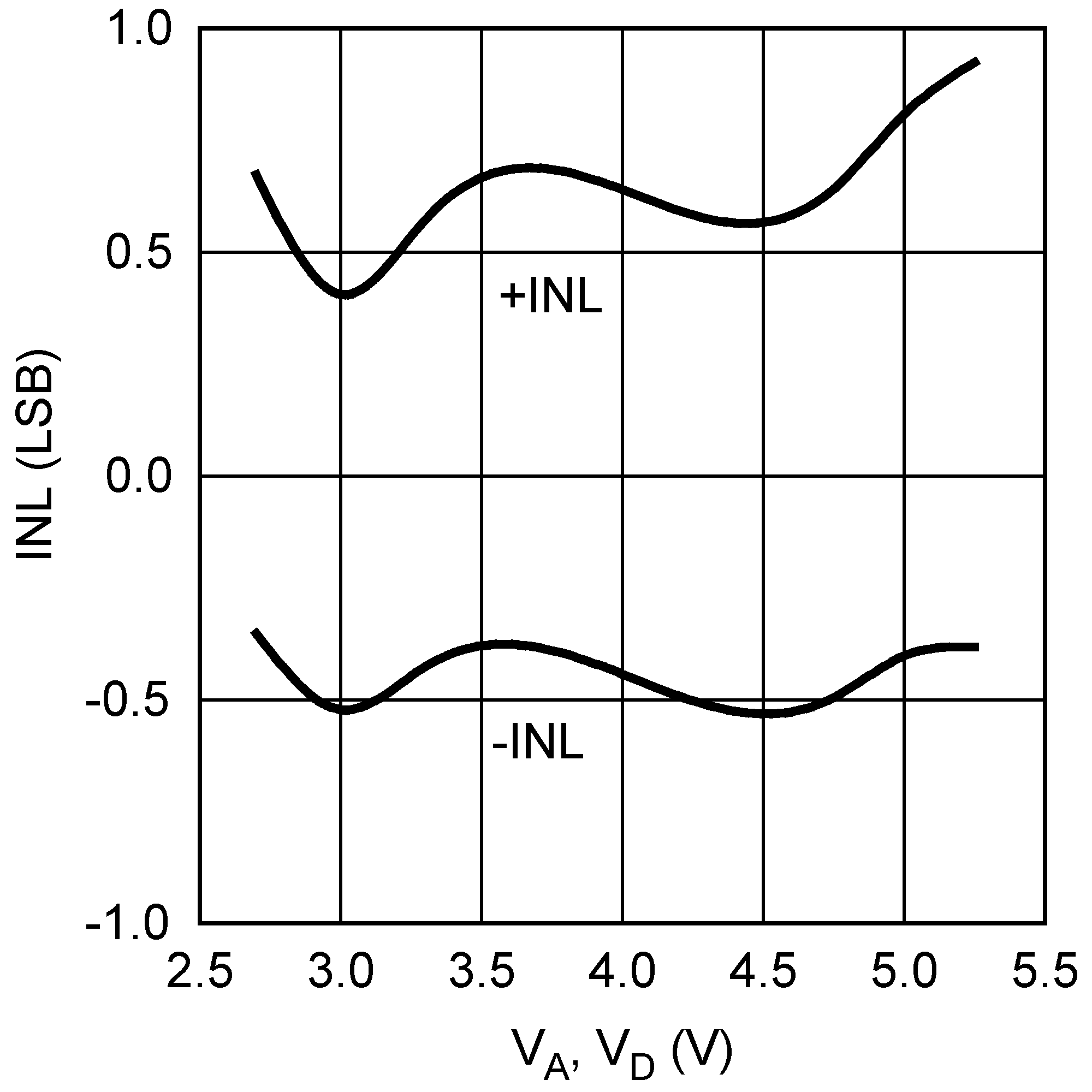 Figure 9. INL vs Supply
Figure 9. INL vs Supply
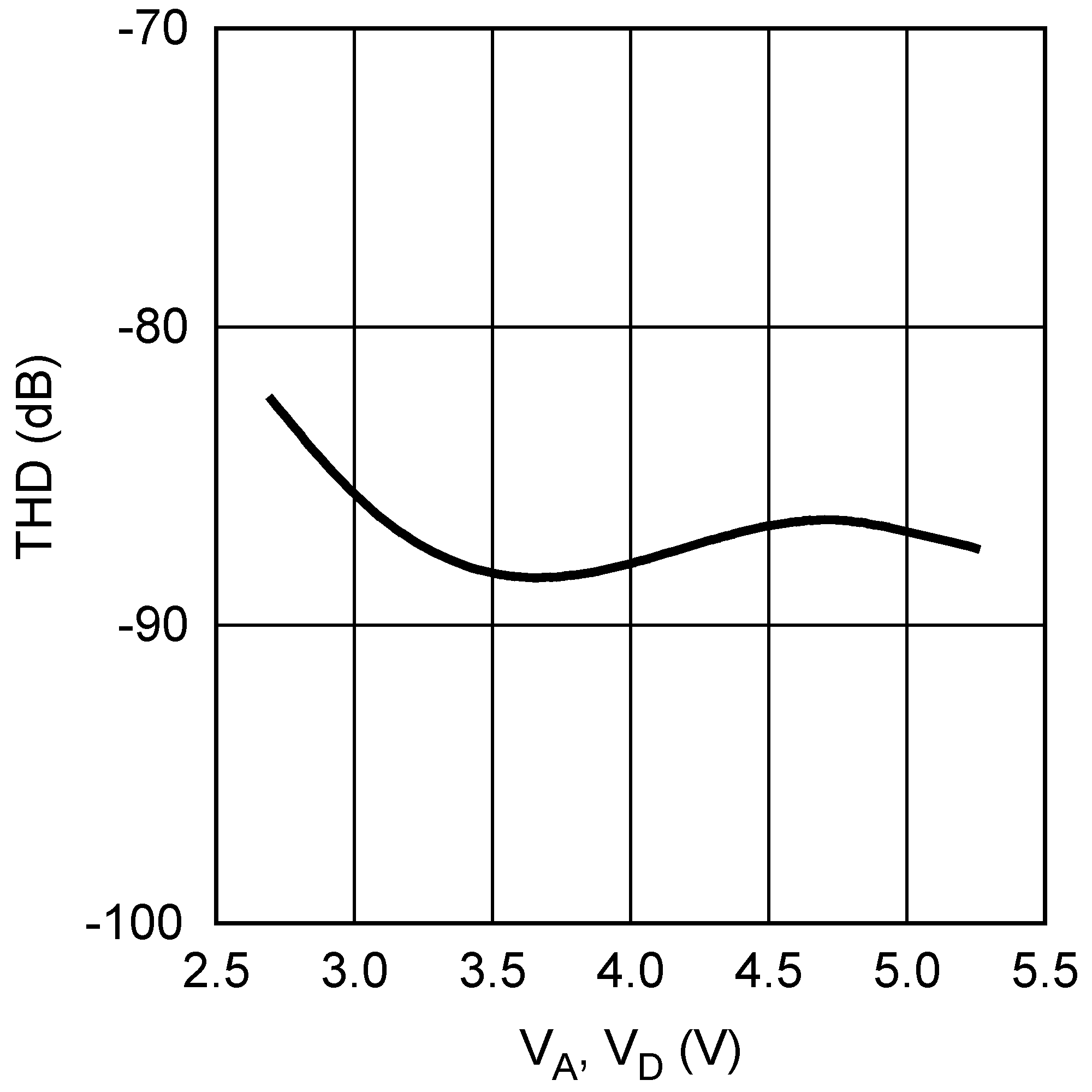 Figure 11. THD vs Supply
Figure 11. THD vs Supply
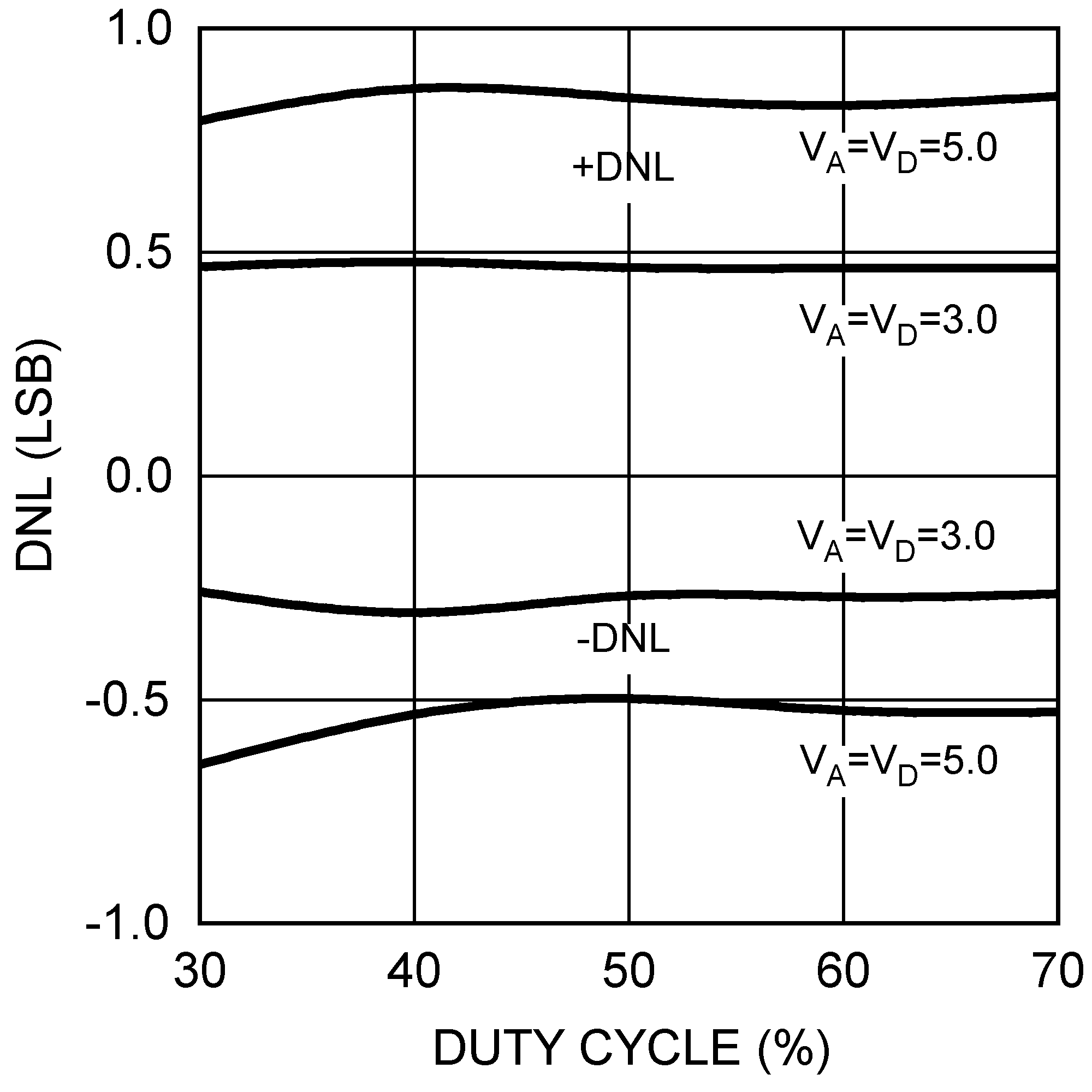 Figure 13. DNL vs SCLK Duty Cycle
Figure 13. DNL vs SCLK Duty Cycle
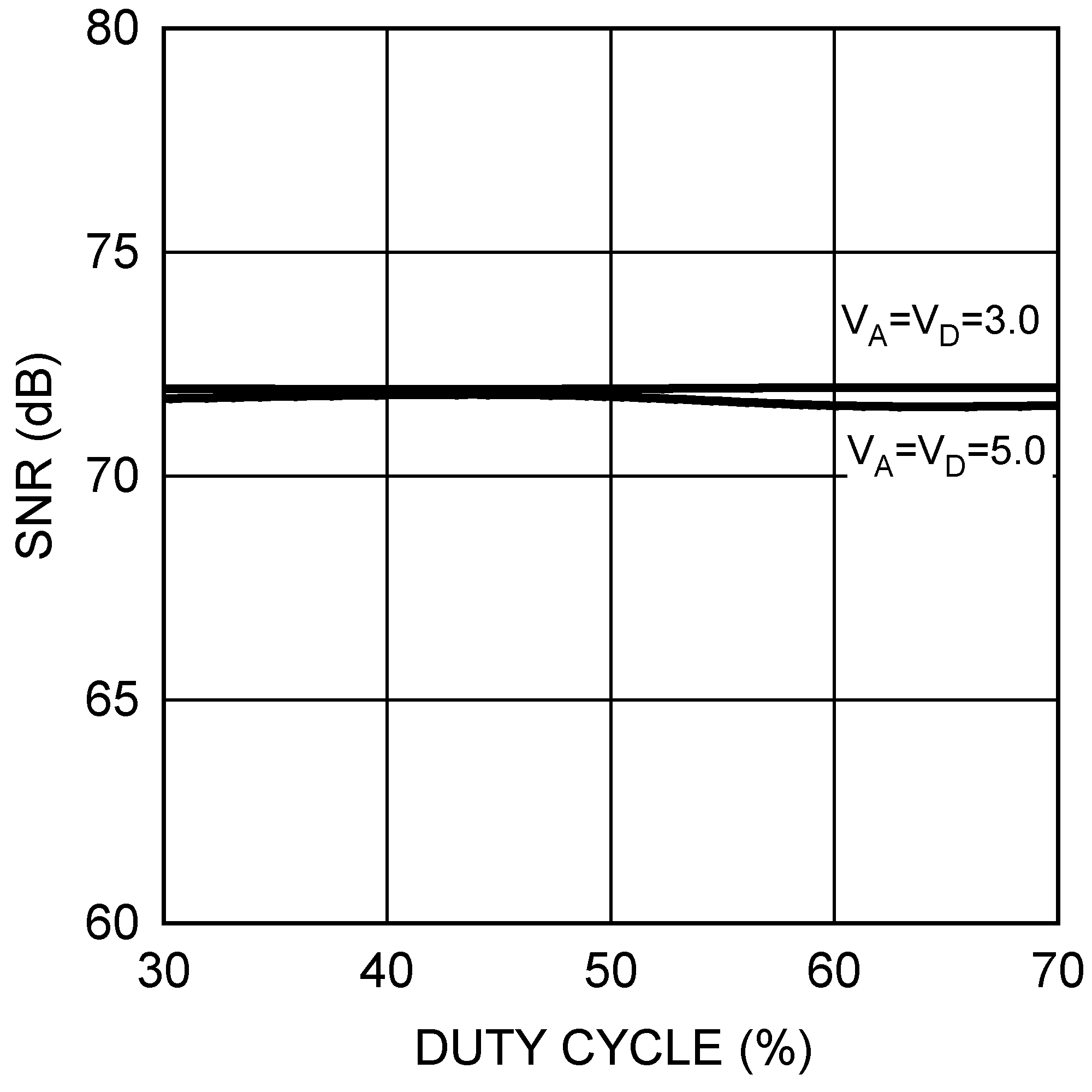 Figure 15. SNR vs SCLK Duty Cycle
Figure 15. SNR vs SCLK Duty Cycle
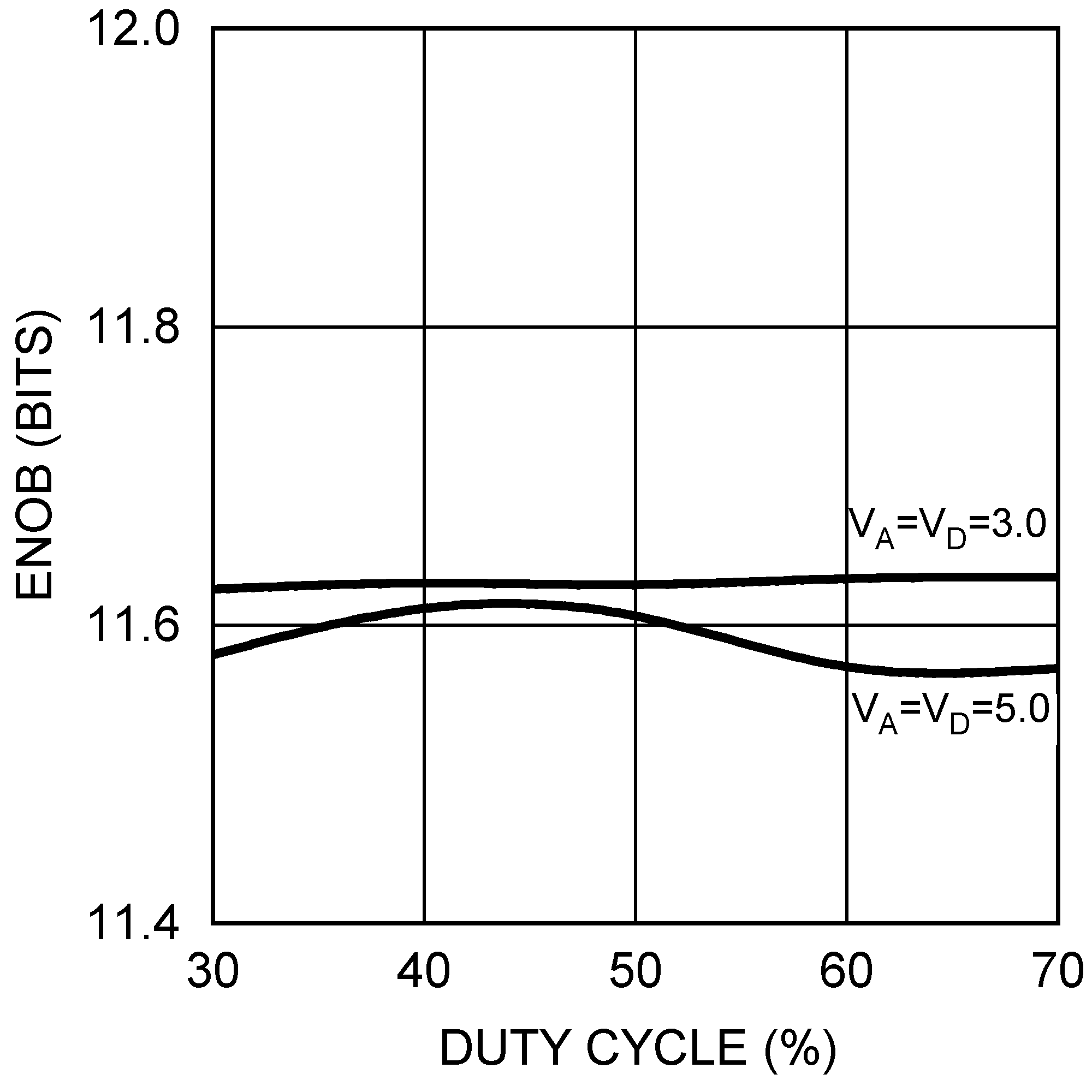 Figure 17. ENOB vs SCLK Duty Cycle
Figure 17. ENOB vs SCLK Duty Cycle
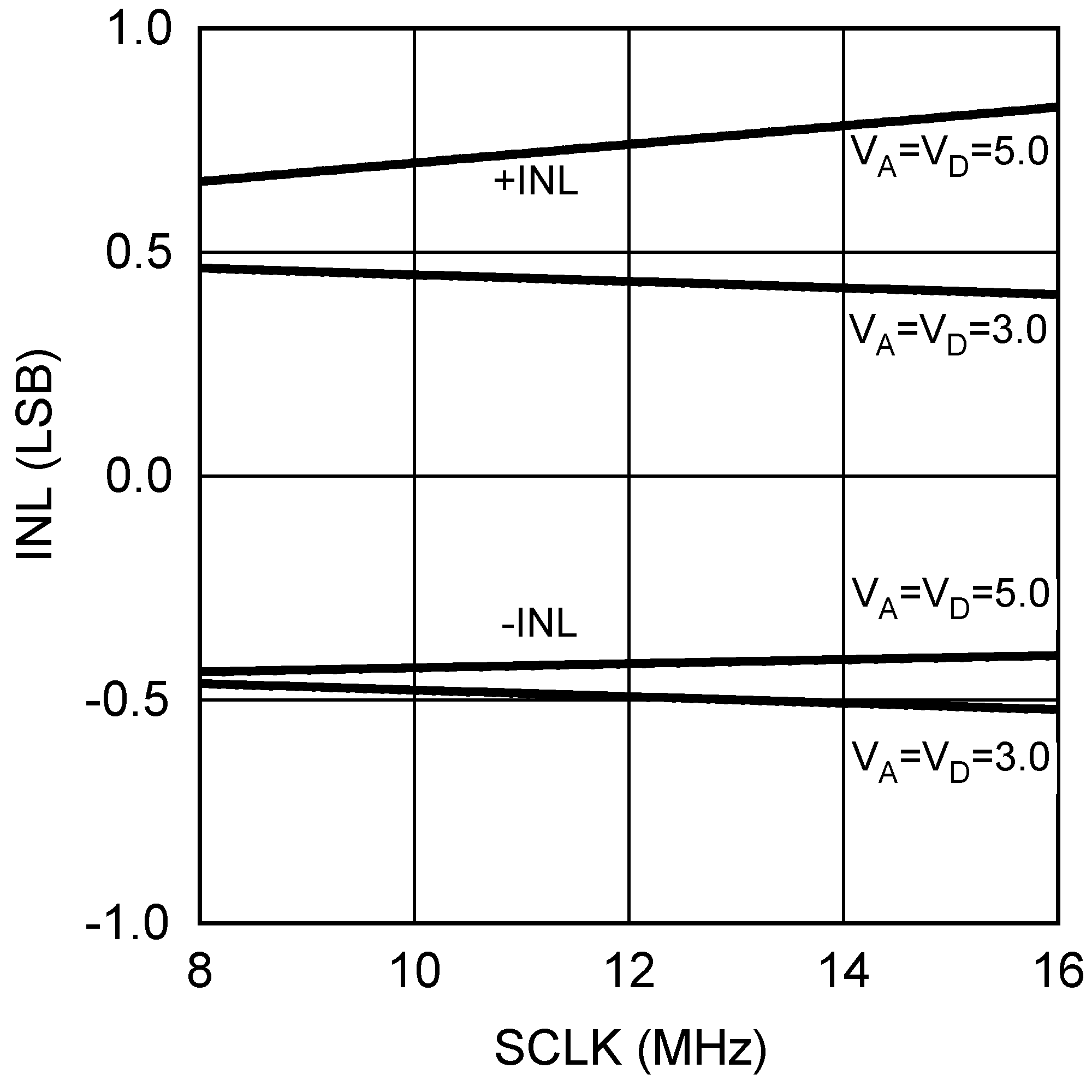 Figure 19. INL vs SCLK
Figure 19. INL vs SCLK
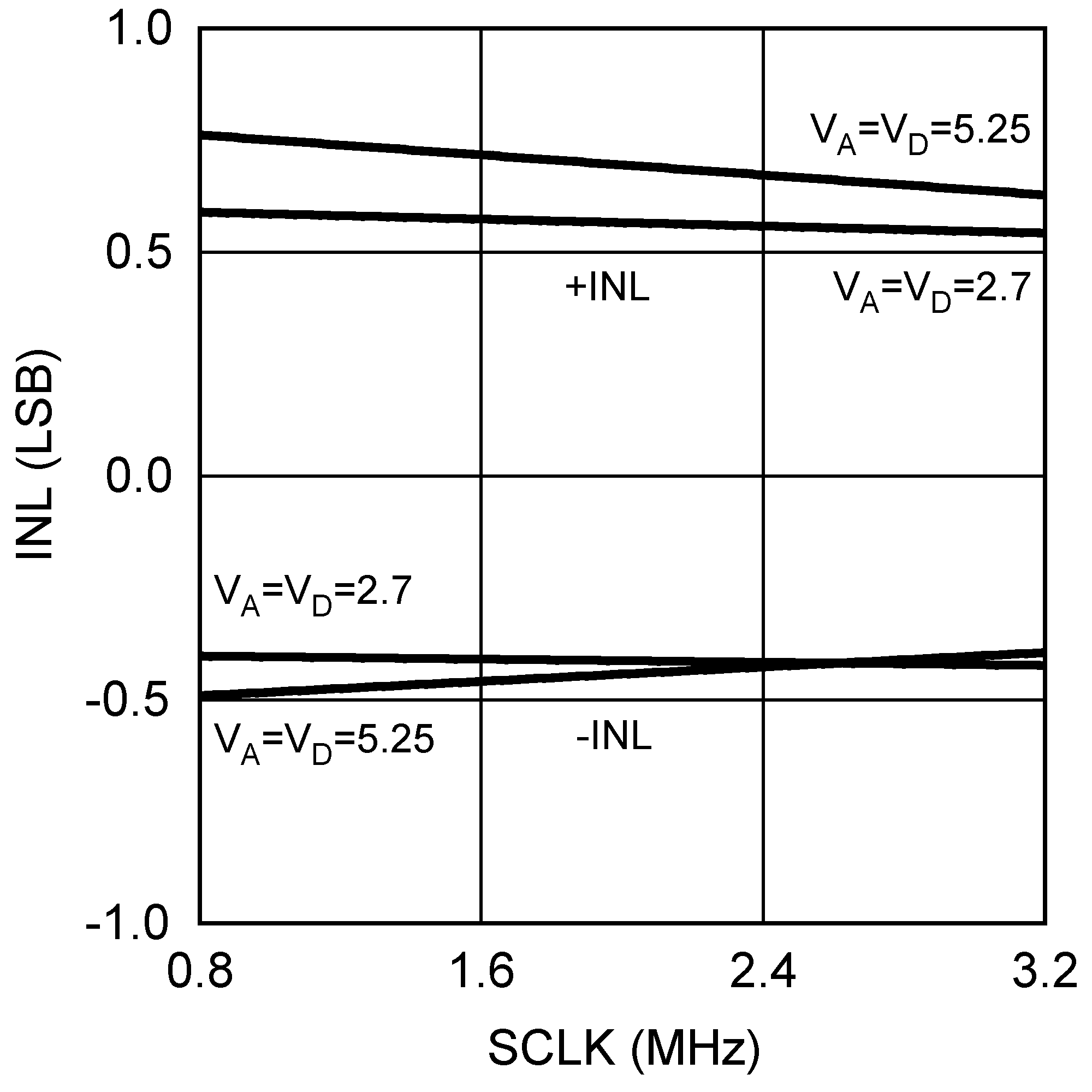 Figure 21. INL vs SCLK
Figure 21. INL vs SCLK
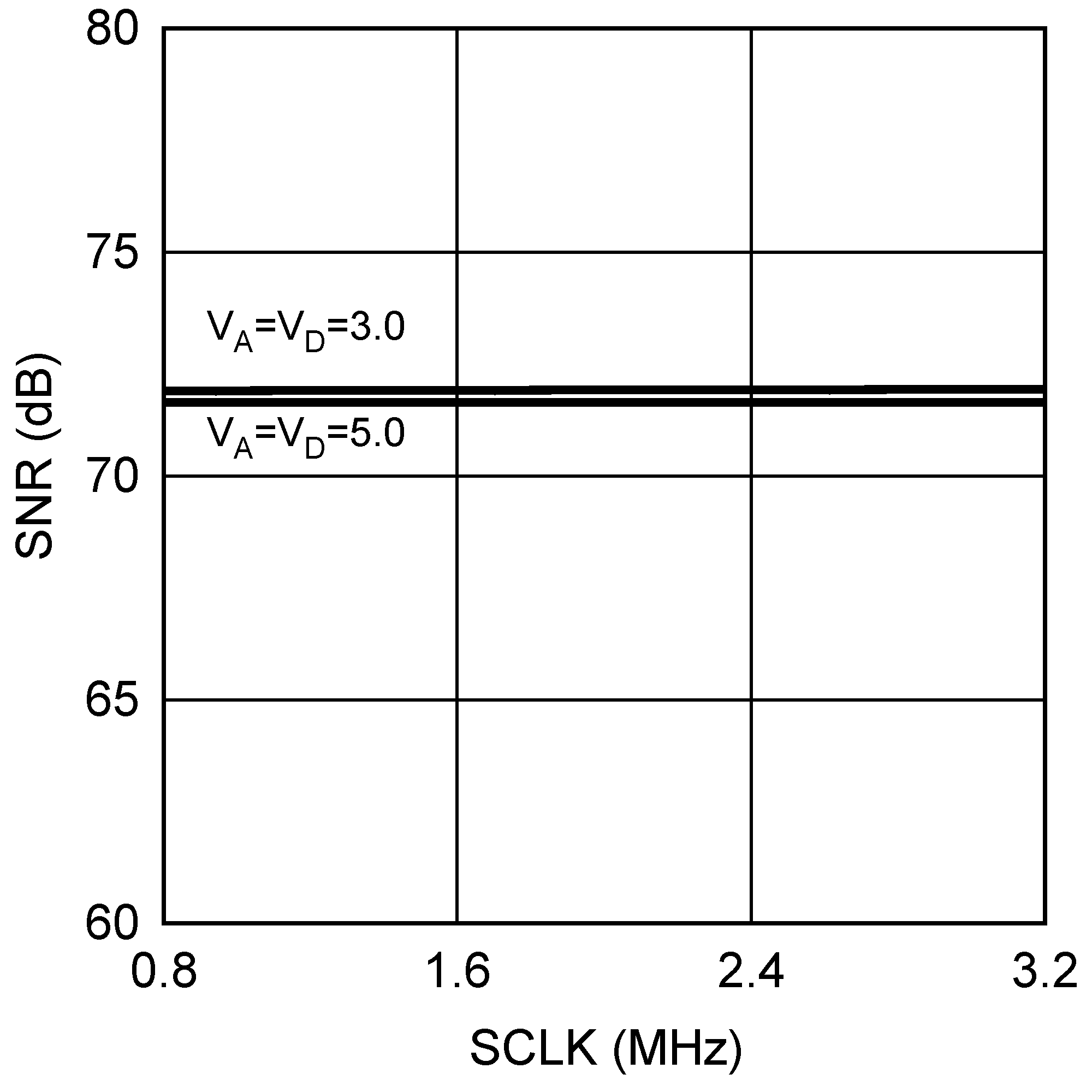 Figure 23. SNR vs SCLK
Figure 23. SNR vs SCLK
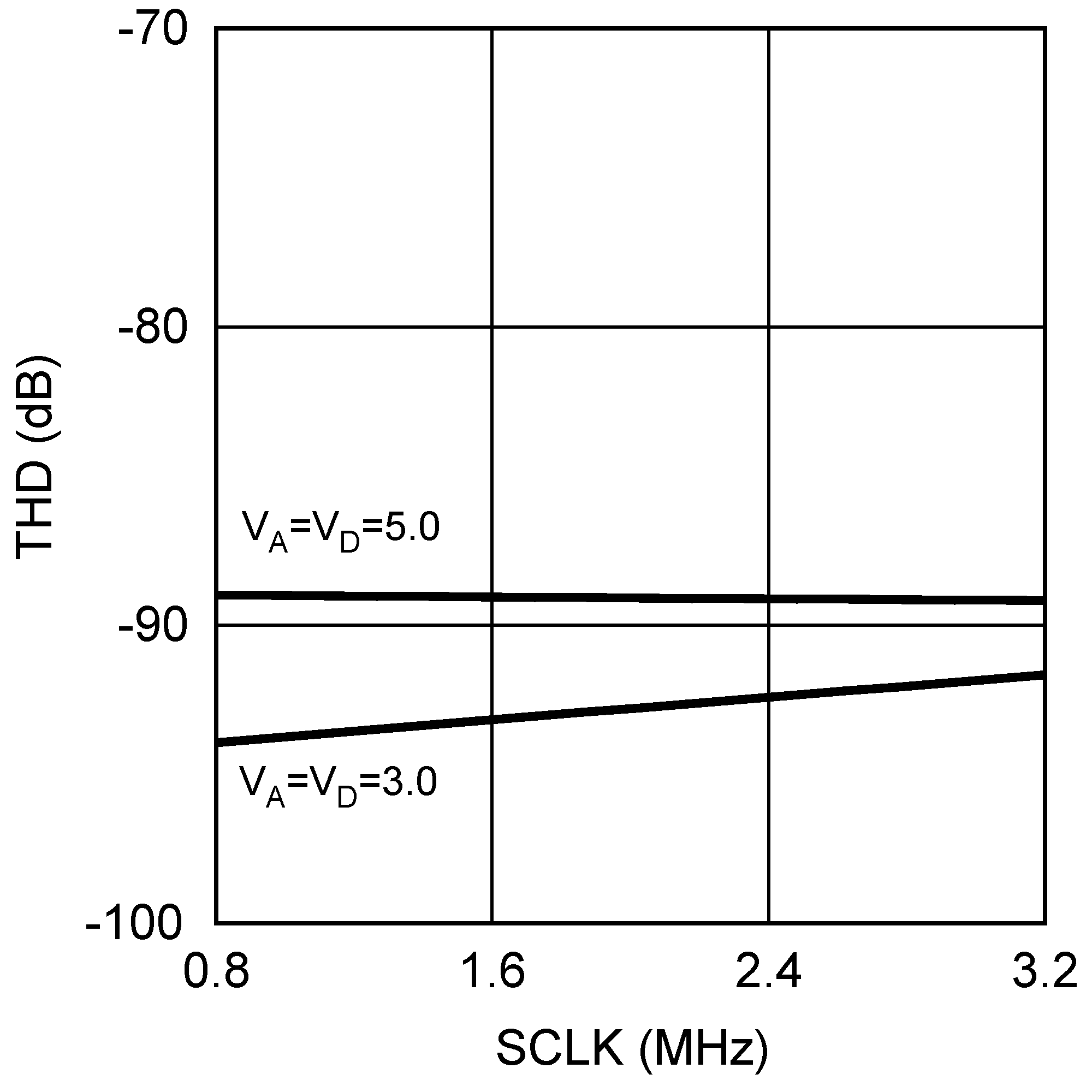 Figure 25. THD vs SCLK
Figure 25. THD vs SCLK
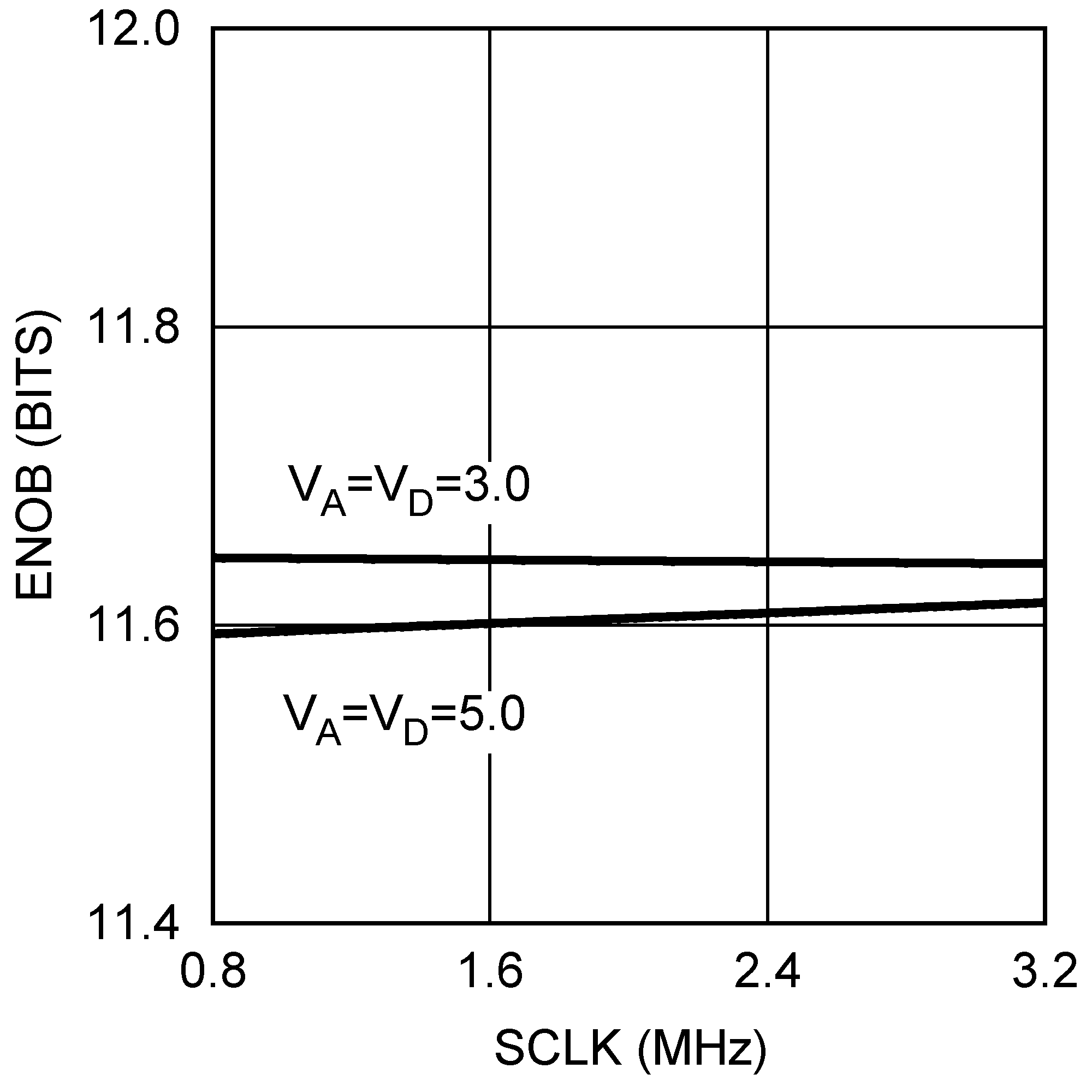 Figure 27. ENOB vs SCLK
Figure 27. ENOB vs SCLK
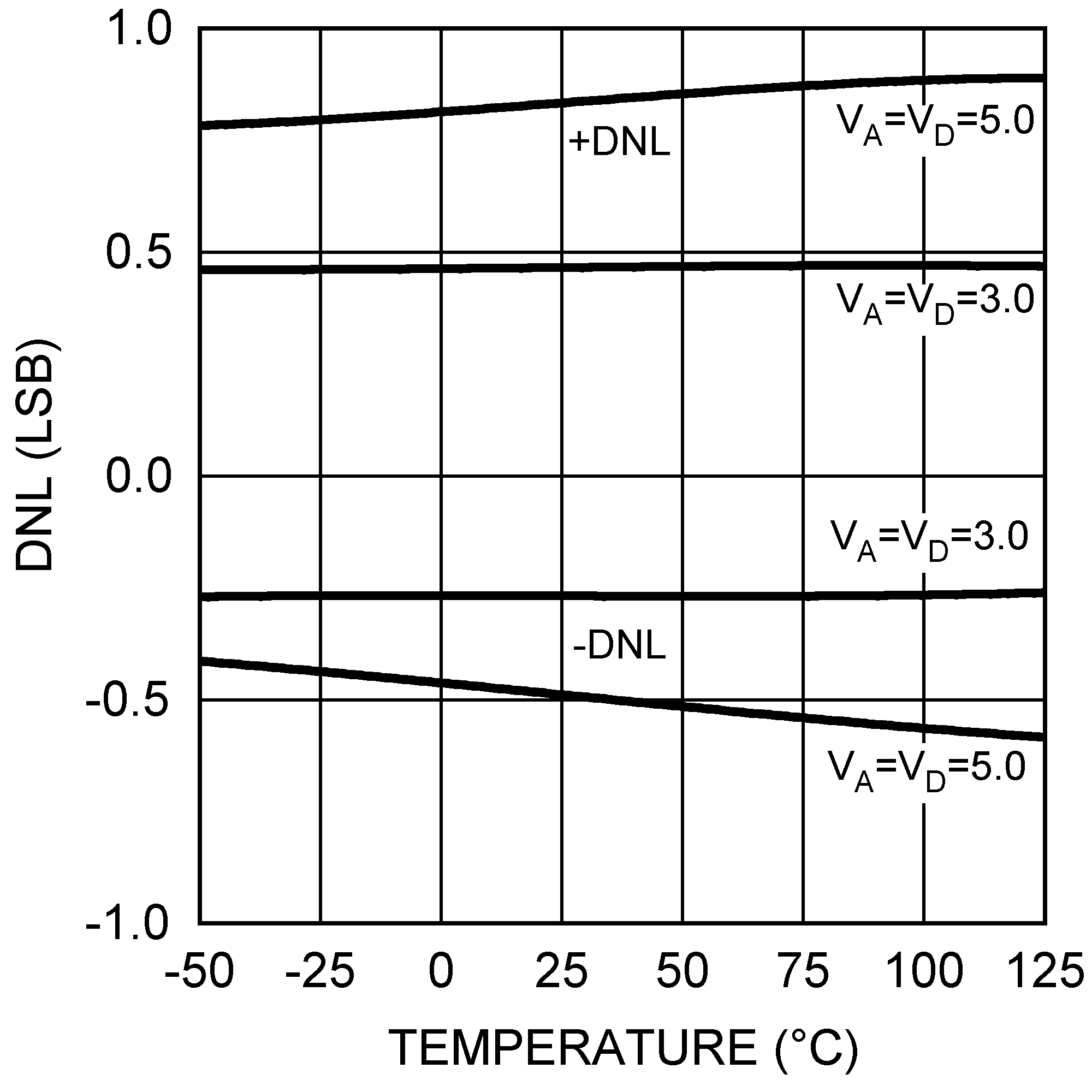 Figure 29. DNL vs Temperature
Figure 29. DNL vs Temperature
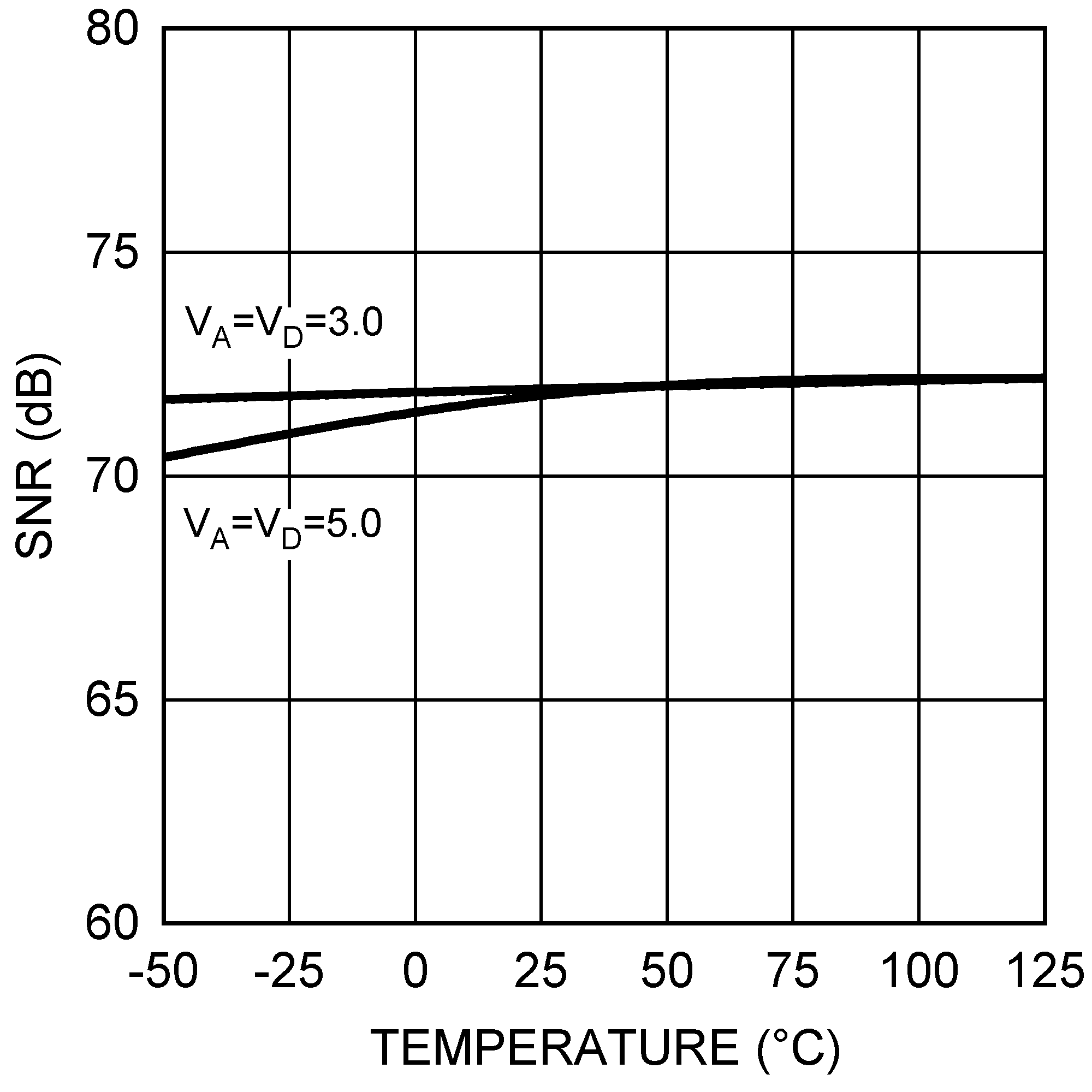 Figure 31. SNR vs Temperature
Figure 31. SNR vs Temperature
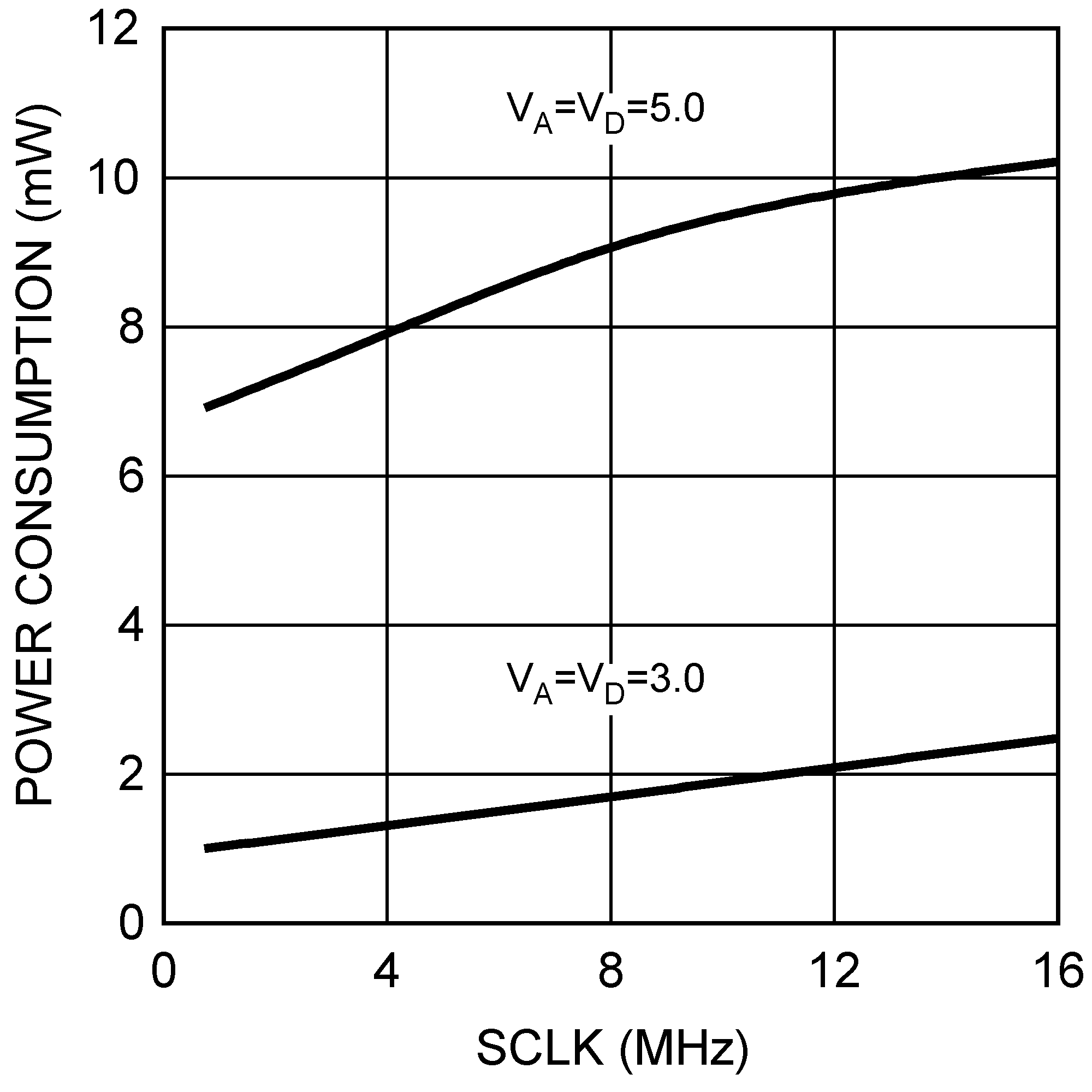 Figure 33. Power Consumption vs SCLK
Figure 33. Power Consumption vs SCLK

